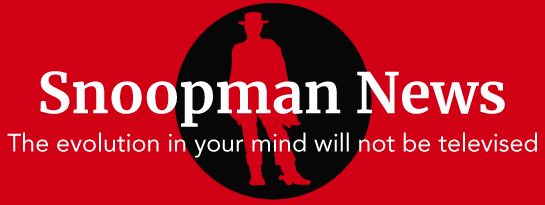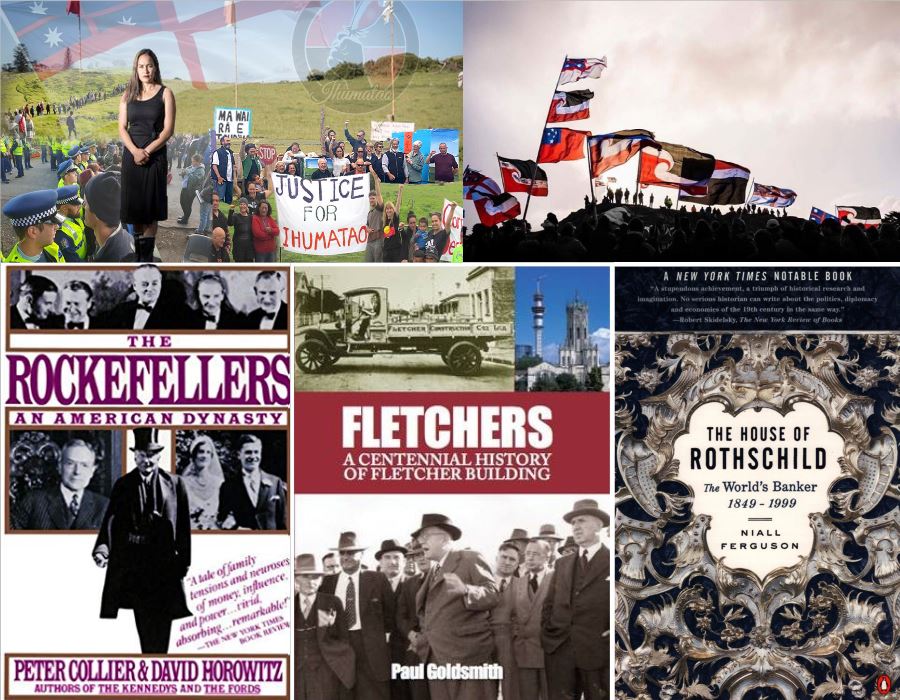
The corporate ancestry, cross-institutional linkages and cross-ownership of Fletcher Building Limited reveals an intriguing web of conniving corporate networks, hidden spidery machinations and conspiratorial structural racketeering. This investigation into the 54%-transnational bank-owned construction corporation’s stalled residential housing project, located near Auckland International Airport on the Ihumātao Peninsula, also reveals a structural racketeering conspiracy plotted by globalists in the orbits of the Rockefellers and Rothschilds, and the Fletcher Dynasty.
Fletcher Building’s corporate ancestor, Fletcher Challenge, was at the centre of a Neo-Feudal Siege inflicted on the New Zealand economy in the mid-1980s to mid-1990s, back when the corporate conglomerate was part-owned by the Fletcher Dynasty. Their involvement in a Neo-Feudal Confederacy – whom engineered crises with the intention to accumulate wealth – means the Fletcher Dynasty consciously participated in racketeering. This economic warfare re-set was part of a broader blueprint called the ‘1980s Project’, which was designed by the Rockefeller Dynasty-controlled Council on Foreign Relations think-tank in New York. The idea was to transform New Zealand into a ‘Switzerland of the South Pacific’ Utopian hi-tech Neo-Feudal wealth-protection haven for rich white centimillionaires and billionaires, such as Ron Brierley, Stephen Jennings, Alan Gibbs, Michael Fay and David Richwhite, and also to create a crisis-ridden society with huge economic wealth disparities and large pools of excess labour for transnationals to exploit.
The transnational banks that majority own Fletcher Building include JP Morgan Chase, which represents a deepening fusion of the Rockefeller and Rothschild dynasties that stretches back to the post-American Civil War period, when the House of Rothschild bank-rolled ‘the Robber Barrons’. The Rothschild’s tentacles also reached into the New Zealand Masonic Revolutionary War of 1860-72, with N.M. Rothschild buying £464,200 worth of N.Z. government debentures from the Bank of New Zealand’s London agent in 1867.
The regulatory capture of the New Zealand Government set in train in 1984 by a Neo-Feudal Confederacy persists today, because New Zealand’s Pākehā-dominated Ruling Class and white supremacist Rich-Listers thrive off this economic warfare paradigm amid the general populations’ obliviousness to the callous design. The Snoopman finds Auckland’s 37th place ranking as a Global City in 2015 servicing 557 Ultra High Net Worthers goes along way to explaining why the disputed land on the Ihumātao Peninsula was stealthily and hastily designated as a Special Housing Area in 2014 amid a housing crisis. This systemic regulatory capture – or the capitulation of authorities to cap the size of big businesses and instead actively facilitate the formation and maintenance of cartelized industries – has continued since the capture of the Lange-Labour Government in mid-1984 by the Neo-Feudal Confederacy.
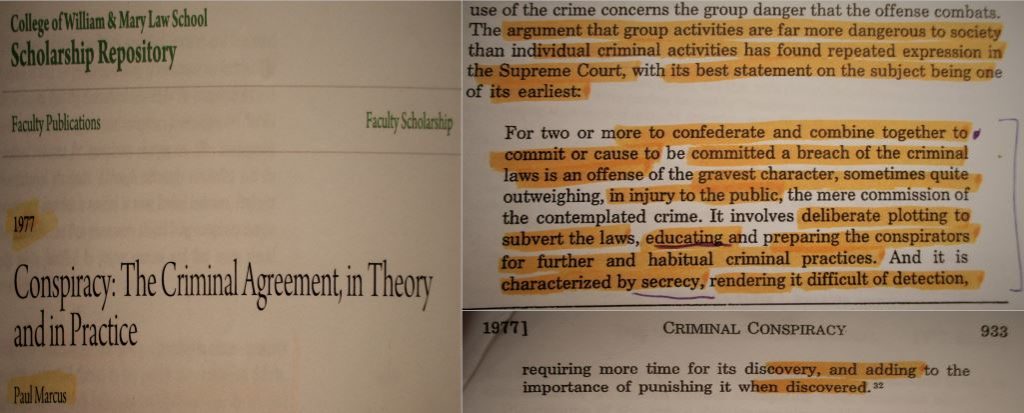
The Snoopman
Fletcher-Rockefeller Dynasties Connection & the Neo-Feudal Siege of N.Z.
The corporate ancestry of the holder to the disputed private land title at Ihumātao – Fletcher Building Limited – reveals the construction company to be a transnational bank-owned cartel up to its corporatist eyeballs in structural racketeering, regulatory capture and contrived ignorance.
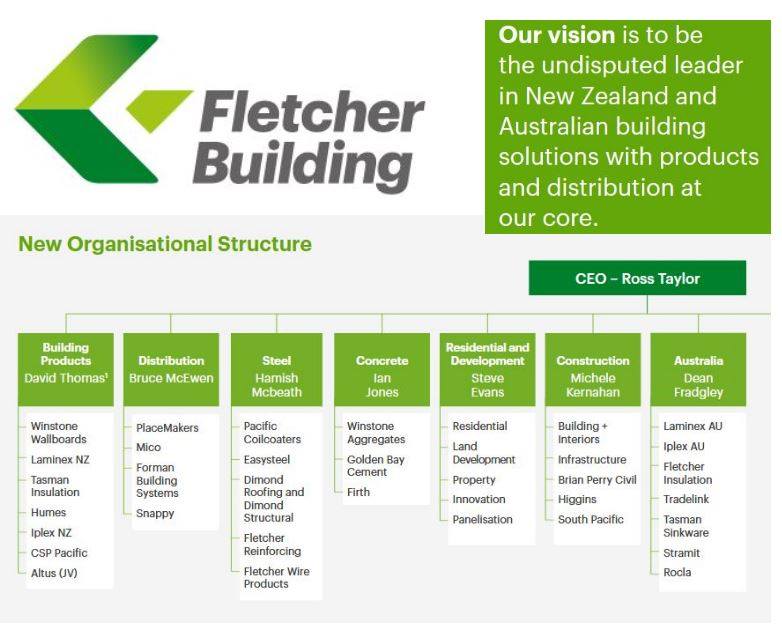
Fletcher Building Limited is the ultimate holding company of Fletcher Residential Limited whom paid $19 million on March 20 2014 for the 33ha contested rural land – the Ōruarangi Block – with the intent to build a residential housing development on the Ihumātao Peninsula. A halt to construction was announced by New Zealand Prime Minister Jacinda Ardern on July 26th 2019 amid a rapid escalation in support for a whenua protection group following a 150-strong Police operation to remove 10 people occupying the contested land just three days prior.
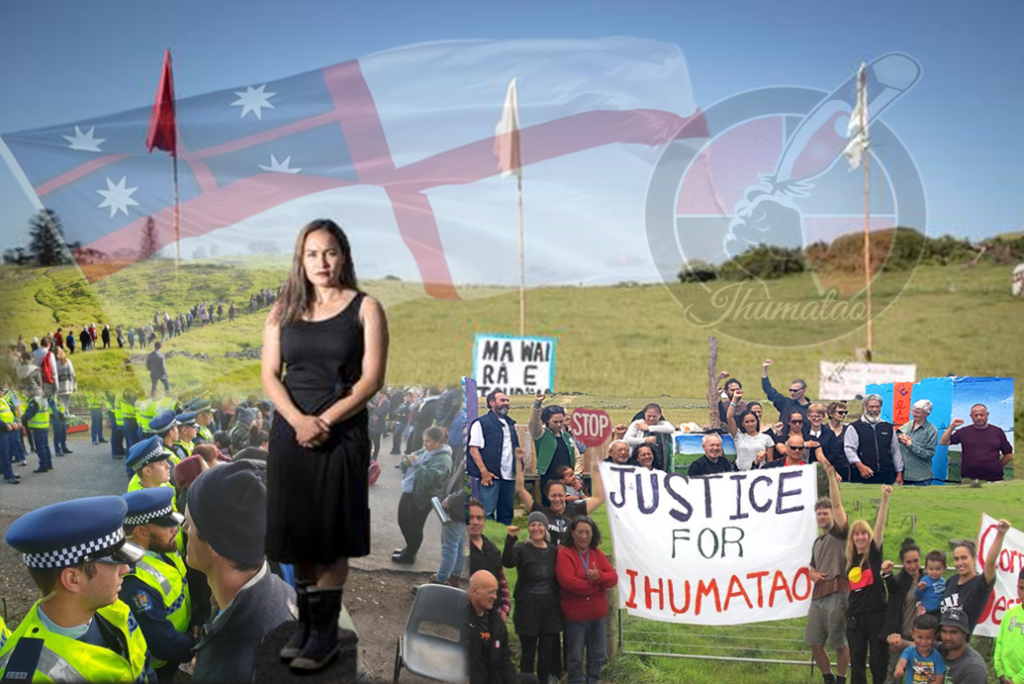
The whenua protection group known as Save Our Unique Landscapes (SOUL) was formed in early 2015 by core founding members known as ‘the six cousins’ — Waimarie McFarland, Qiane Matata-Sipu, Bobbi-Jo Pihema, Moana Waa, Haki Wilson, and Pania Newton — to stop the destruction of the historically significant land adjacent to the Ōtuataua Stonefields Historic Reserve. It was the Newton-led occupation of the whenua that has culminated in a battle for control of the whenua, as well as a high stakes battle for control of the narrative, with an election year looming.

Among the slew of Fletcher brands, tax-sheltering ‘elsewhere entities’ and merged alter-ego companies masquerading as competitors, is Fletcher Building Nominees Limited – the corporate consortia formerly known as Fletcher Challenge Nominees Limited. Fletcher Challenge was incorporated on 27th November 1981 when the son of Fletcher dynasty founder Sir James Fletcher I (1886-1974) – James (Jim) Fletcher II (1914-2009) – merged Fletcher Holdings and Tasman Pulp & Paper Co with Ronald Ramsay Trotter’s stock and station agents firm, Challenge Corporation, to form New Zealand’s biggest corporate conglomerate – for a brief time.i
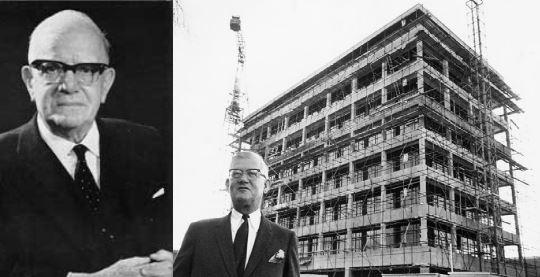
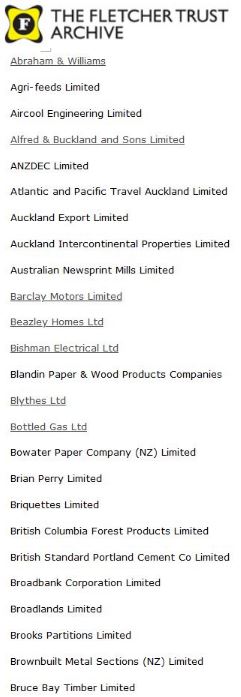
A New Zealand Zaibatsu: The Fletcher Dynasty have never adequately explained how a construction company came to acquire so many companies, especially from the 1960s through to the end of the century.
The Fletcher business began as The Fletcher Construction Company in 1915 after a brief period as Fletcher Bros Limited, which was established in 1909 and was floated as a public company in 1942 as Fletcher Holdings. By the time the company’s primary founder James Fletcher died in 1974, his second son James Muir Cameron Fletcher or ‘JC’, had transformed the public company into a consortia of diversified businesses. The agglomeration of firms such as Fletcher Construction, Fletcher Industries, Tasman Pulp and Paper, Pacific Steel and products such as Asbestos, Formica, Winstone particle board and Marac consumer finance – together resembled a Japanese zaibatsu, or a conglomerate controlled by one or two families.iii
As Chairman of Fletcher Challenge, Sir Ron Trotter (1981-1990), and as the inaugural Chairman of the Neo-Feudal think-tank, the New Zealand Business Round-Table (1985–1990), and as Chairman of State-Owned Enterprises Steering Committee (1987-1988), he played an instrumental role in the Neo-Feudal corporate raiding takeover of the New Zealand economy during the mid-1980s to mid-1990s – when the Realm got mangled.iv
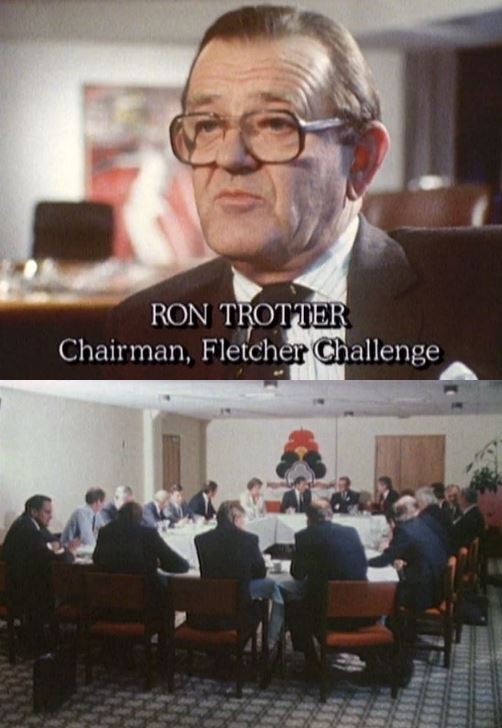

The New Zealand Business Round-Table evolved out of a group of CEOs, including Jim Fletcher, Ron Trotter, Alan Hellaby and Ray Wattie, who strategized in the late 1970s to support the Employer’s Federation on industrial relations at a time when unions were fighting a cap on pay-rates amid a high-inflationary period caused by the 1970’s Oil Price Shocks. This group came to call themselves the Round-Table. Its corporate membership – which included Fletcher Challenge, Fay Richwhite, Brierley Investments, Lion Nathan, Telecom, Toyota, the BNZ, ANZ, ASB, the National Bank, Westpac, AMP, Goodman Fielder, Gibbs Securities, First NZ Capital (CS First Boston), Heinz Wattie, Farmers Deka, Saatchi & Saatchi, Whitcoulls and Woolworths – reads like a ‘Who’s Who of Who Dunnit?’ in an unsolved national siege case (rumoured to be left languishing on top of a filing cabinet at Police Headquarters in Wellington, and which gets a dust over once a year by Samoan cleaners during the Christmas break). Indeed, if a retro New Zealand edition of a Monopoly-esque game were invented with a Neo-Feudal ‘market economy’ twist and called say, Oligarchy, that showed how the wealthy and well-connected captured the strategic resources of entire countries, the New Zealand Business Round-Table would surely have a square compelling unhappy players to lose resources to players holding the coveted ‘Privatize Card’ if they landed on it due to a weird casino-economy-voodoo sabotaging a dice roll.

The corporate raiding of New Zealand’s state assets – which involved the rapid, broad-scope corporatization, privatization and cartelization of state-owned commercial trading enterprises, infrastructure, and public services – included numerous un-mandated objectives.v Fletcher Challenge, the Fletcher Dynasty and Ron Trotter were deep in this racketeering rabbit hole. Along with other corporate members of the Business Round-Table, the Fletchers, Trotter and associates had either engaged in racketeering, which is the deceptive practice of offering solutions to problems created through concealed means to extort money, assets or pecuniary stake in enterprises. Or, they had wittingly joined the siege of the New Zealand economy after it was underway.
By December 1996, firms linked to the Business Round-Table accumulated $12.542 billion of the paltry $15.322 billion paid for privatized state assets, including Fletcher Challenge, which bought one-fifth and the investor orbit of Ron Trotter bought a third – according to the Australian Citizens Electoral Council.vi Fletcher Challenge scooped up state-owned oil, gas and forestry assets for a fraction of their worth.vii For example, the Forestry Corporation of New Zealand, or ForestCorp, was sold in 1996 for $1.6 billion to Fletcher Challenge (37.5%), Brierley Investments (25%), and Citifor Inc (37.5%).

By the time Fletcher Challenge was broken up, and various parts sold off in March 2001, Fletcher Challenge had destroyed around $8.5 billion of shareholder wealth by “getting into the wrong businesses, paying too much for them and failing to make proper adjustments when that became evident” – as New Zealand Herald reporters Carroll Du Chateau and Warren Gamble relayed ANZ Bank’s spin on the ‘incompetence’, rather than skewering the Fletcher Dynasty in “Fletcher – End of am Empire” for their part in a systematic attack on working class wealth.viii
Economic ‘Shock Therapies’ that were inflicted on New Zealand included the re-structuring of the public sector with a corporate model, a sell-off of state-owned commercial enterprises, and de-funding of critical public services, especially in the provinces. These shock therapies drove ten of thousands to Auckland in search of work – as planned. This capture of the Public State by a Deep State Neo-Feudal Confederacy was orchestrated for the purposes of facilitating the hostile corporate takeover of the New Zealand economy, so it could be transformed into a ‘Switzerland of the South Pacific’ Utopia.
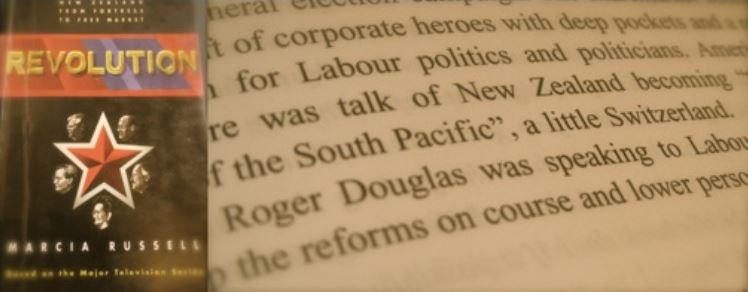
The idea was to create a top-strata of wealthy people, that would produce structural conditions wherein ‘most New Zealanders would find the country an unaffordable place to live in 25 years time’, as then-Finance Minister Roger Owen Douglas in the Lange-Labour Government stated at a private dinner in December 1986.ix This Neo-Feudal Confederacy intended to replace the domestic population with vulnerable working class immigrants, and a wealthier immigrant professional service class, and a domestic-foreign capitalist class, to shove New Zealanders out – including Māori.
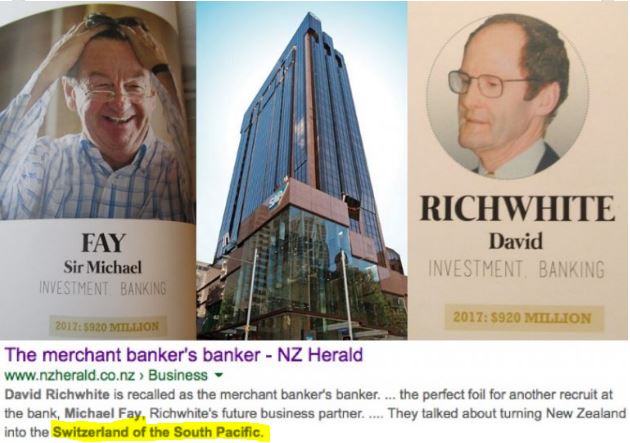
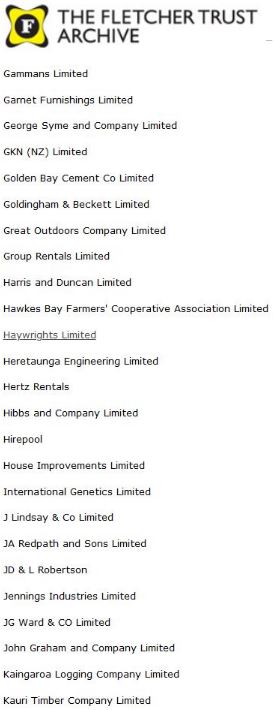
Indeed, in the mid-1980s, merchant bankers Michael Fay and David Richwhite shared with investors their ‘Switzerland of the South Pacific’ utopian vision, which including transforming for New Zealand into a foreign exchange capital of the South Pacific.x In late 1986, the pair floated a company called European Pacific Banking Corporation, which they formed with Ron Brierley,xi that was based in the wealth secrecy haven of Luxembourg.xii Ironically, after Fay and Richwhite’s credibility plummeted following the Cook Islands ‘Wine Box’ tax evasion scandal in the mid-1990s when European Pacific’s exploitation of the jurisdiction as a tax shelter came under scrutiny, the state-raiding accomplices became ‘tax-exiles’ in the Knights Templar-founded Federal Republic of Switzerland in 1998xiii – after selling their mansions for the fraternally-symbolic sum of $13 million.xiv The trajectory set by Brierley, Fay and Richwhite to transform New Zealand into a financial secrecy haven favourable for undead transnational banking cartels peddling credit – while their undead Neo-Feudal Casino Economy keep actual cash scarce – is still alive.
🎯
The Fletcher Connection »»
These un-mandated objectives are detectable in the activities of the Fletcher Dynasty’s founder, Sir James Fletcher I (1886-1974) and his son Sir James Muir Cameron (‘Jim’ or ‘JC Junior’) Fletcher II (1914-2007), whom both used to rub shoulders with the Rockefeller Dynasty’s leading patriarch, David Rockefeller, at the ḗlite invitation-only International Industrial Conferences. In his sanitized biography, Made in New Zealand: The Story of Jim Fletcher, Selwyn Parker mentions the old Sir James Fletcher attended these conferences in San Francisco that comprised 500 of the planet’s leading industrialists, bankers and feudalists from the very first one in 1957 and by 1969, his son Jim was on the policy board.xv
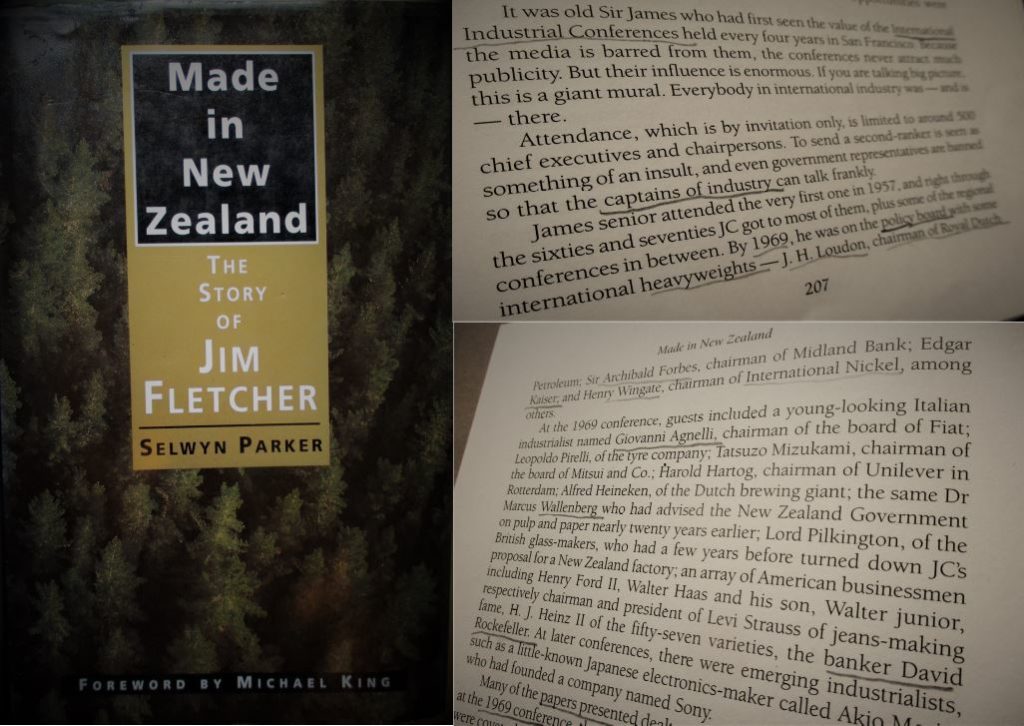
Present at that 1969 conference was the chairman of Chase Manhattan Bank, David Rockefeller, as well as Fiat Chairman Giovanni Agnelli and Marcus Wallenberg of Swedish Wallenberg banking dynasty. Tellingly, Jim Fletcher was at the 1973 conference and he recalled that a representative of OPEC, Sheik Yamani, discussed oil prices before the first oil price shocks. This fleeting recollection reproduced the myth that the 1973 Oil Price Shocks were all the fault of Arab oil producing countries’ cartel, known by its sanitized name, the Organizaton of the Petroleum Exporting Countries.
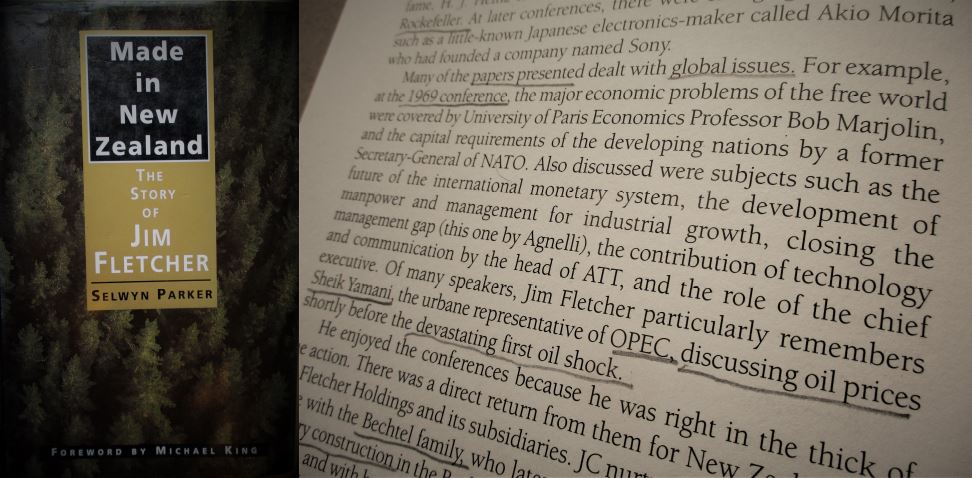
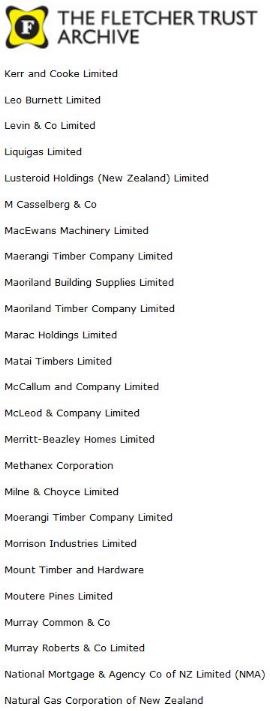
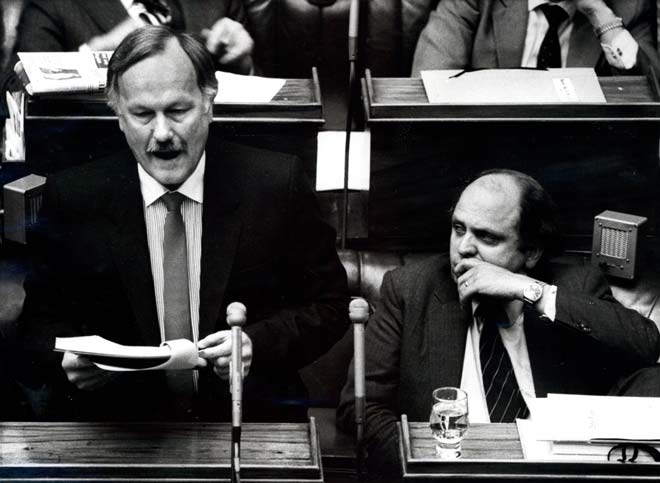
The intriguing truth is that the 1973-74 Oil Price Shocks were masterminded by a Rockefeller-Kissinger-Bilderberger Nexus. The malicious purpose was throw the world into an economic crisis amid rapidly rising oil prices, coerce governments to borrow emergency funds and weaken resistance to a blueprint in the pipeline, called the ‘1980’s project’, for reasserting dominance over the world, as The Snoopman shows below in the sub-terrain section: “The Fletcher-Rockefeller-Rothschild Dynasties Rabbit Hole”.
The infliction of those oil price hikes is of relevance to Ihumātao and the Fletcher-Rockefeller-Rothschild Dynasties connection because it ultimately led to the corporate takeover of the New Zealand economy. The Neo-Feudal Confederacy that drove the corporate raid on New Zealand between 1984 and 1994 produced structural pressures to create a crisis-ridden society, including a housing crisis, which led to the rural land at Ihumātao being designated as a Special Housing Area.
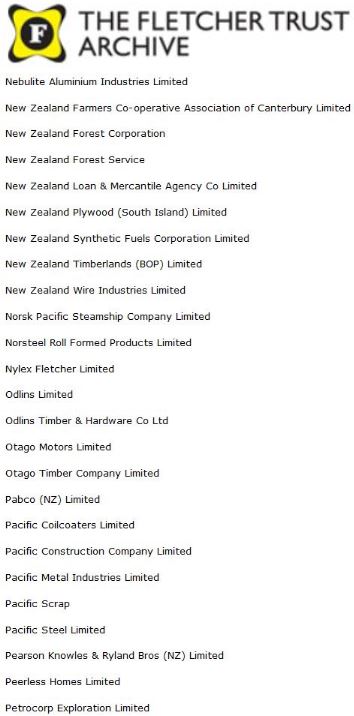
This Neo-Feudal Confederacy’s corporate siege of New Zealand was steered by the triple-hatted Ron Trotter, who as Chairman of Fletcher Challenge, (1981-1990), and as the inaugural Chairman of the Neo-Feudal think-tank, the New Zealand Business Round-Table (1985–1990), and as Chairman of State-Owned Enterprises Steering Committee (1987-1988) – enriched himself as well as his cronies, in the privatisation of N.Z.’s state assets that he directed.
The gaming of New Zealand advanced on Robert Muldoon’s watch as Prime Minister (1975-1984) when large industrial development ‘loans’,xvi liberalizing regulatory controls over the share market, xvii and legislating voluntary union membership were legislated.xviii As Fletcher Challenge Chairman, Ron Trotter, used to go on Sunday walks with Muldoon cabinet minister Hugh Templeton, who played an instrumental role in forging the Trans-Tasman economic trade bloc known as Australia New Zealand Closer Economic Relations (ANZCER), as Stevan Eldred-Grigg mentions in his seminal book, The Rich: A New Zealand History.xix The forerunner to the Trans-Tasman economic trade bloc was the original NAFTA, or the New Zealand Australia Free Trade Agreement, which was the dream of Jim Fletcher, who evidently wanted to level the playing field for the Fletcher-Government owned consortium Tasman Pulp and Paper Company.xx

However, Jim Fletcher’s worldview was globalist, meaning he was in the camp with the New World Order Utopian vision, that includes the forging of regional trade blocs, such as the Trans-Pacific Economic Bloc Treaty, to subvert nation state sovereignty, undermine indigenous self-determination and valorize a techno-Neo-Feudalist commercialized sovereignty of the super-rich. In this way, NAFTA’s Neo-Feudal ‘free trade’ progeny, the Trans-Tasman economic trade bloc known as Australia New Zealand Closer Economic Relations (ANZCER), was (and remains) part of the broader white supremacist New World Order Utopian vision that seeks to build-out hi-tech, corporatized totalitarian super-states.xxi

To that end, in 1971, Muldoon had succumbed to intense lobbying from the Broadlands Dominion Group to allow foreign firms access to merchant banking. At the time there was only one merchant bank, the domestically owned New Zealand United Corporation established in 1960. Four merchant banks with foreign ties – MARAC, Chase-NBA, Broadbank and South Pacific Merchant Finance – soon emerged. The Chase-NBA New Zealand merchant bank was formed between the Rockefeller-controlled Chase Manhattan Bank of New York and the National Bank of Australia, and was headed by future Neo-Feudal Rich-Lister, Alan Gibbs. Broadbank’s first CEO was headed by future Reserve bank Governor Don Brash (1988-2002), and was formed in a joint venture between Broadlands Dominion Group and Wells Fargo Bank of San Francisco.xxii Gibbs and Brash developed an offshore market in New Zealand dollars at a time when currency speculation was being pioneered to take advantage of a successful Wall Street-City of London financial-political coup in which the strings of the Rockefeller-puppet President Nixon were pulled to un-peg the US dollar’s convertibility from a stable value of gold, as William Engdahl shows in, A Century of War: Anglo-American Oil Politics and the New World Order.xxiii It was this offshore market in New Zealand dollars that would become the mechanism of coercion during the financial-political coup of mid-1984, when ‘currency speculators’ attacked the N.Z. dollar (as we shall soon see).

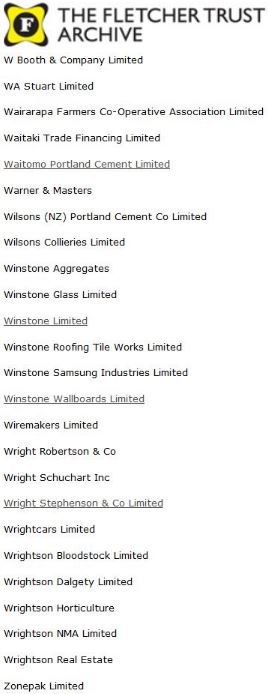
The Neo-Feudalists prime political puppet was Muldoon, who led a virtual double-life as chairman of the International Monetary Fund and the World Bank board of governors in 1979 and 1980.xxiv This top banking positions placed him in a position to ‘borrow’, and symbolically signalled New Zealand was about to become the First World’s pre-eminent Shock Therapy test lab – without him necessarily knowing it. The Muldoon Government undertook heavy borrowing for energy infrastructure, dubbed Think Big Projects, that included building oil refinery, petroleum and gas plants, platforms and pipelines. However, the Neo-Feudal ‘Free Market’ Sect tried to get Muldoon to implement their plans to further de-regulate and privatize the economy in 1979, but the second round of the Oil Price Shocks triggered by the Iranian Revolution to oust the Rockefeller-Kissinger-Bilderberger puppet dictator of Iran, Mohammad Reza Pahlavi, and this new oil shock caused Muldoon to hunker down and tighten his control over the economy.xxv
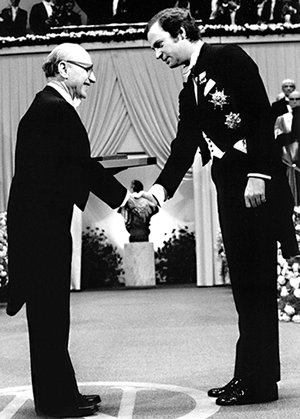
In 1981, an economics professor from the Rockefeller founded-University of Chicago, Milton Friedman, made his first visit to New Zealand, which was the result of an invitation from Don Brash (and one other), before he became Reserve Bank Governor in 1988.xxvi Friedman was here to prepare the ground to transform the Realm into a live experimental shock laboratory through the applications of the ‘Shock Doctrine’ crisis scenarios described by Canadian journalist Naomi Klein in her groundbreaking study, The Shock Doctrine (although she did not cover New Zealand).xxvii Friedman taught to his students, dubbed the ‘Chicago Boys’, how to inflict economic warfare and emphasized a concept of ‘speed, suddenness and scope’. His ‘Chicago Boys’, were among the many economic missionaries who spread ‘free market’ shock policies around the world. These economic shock therapies were field-tested on countries such as: Brazil in 1963, Indonesia in 1965, Chile and Uruguay in 1973 and Argentina 1976 using US-backed military violence to destroy the Developmentalist Movement, as Naomi Klein showed in her 2007 book, The Shock Doctrine. This globe-trotting Shock Doctor visited Bueno Aires in March 1975 to advise his Chicago Boys about how to outflank manufacturers who were getting wiped out by speculative ‘piranhas’, convince the genocidal dictator General Jorge Rafael Videla to double-down on the ‘shock treatments’ and use the state-controlled media to sell his ‘socialist’-curing Snake Medicine.li Friedman’s Chicago Boys ran the Argentine economy under General Videla’s brutal genocidal rule whose Jesuit-supported military junta disappeared more 30,000 black-listed dissidents by dropping them into the Atlantic Ocean from aircraft, between 1976 and 1981. This co-founder of the Anglo-Swiss Neo-Feudal Mont Pèlerin Society received such favourable press when he visited New Zealand in 1981. It would be fair to say that journalistic submission preceded regularity capture. In other words, the capitulation of the Wellington’s Political Élite, meant they became Regulation-Lite turn-coats working in service to the Neo-Feudal capitalist coalition and their flipping followed the fawnification of the political and business press, who were turned as easy as a family pizza at Pizza Hutt.
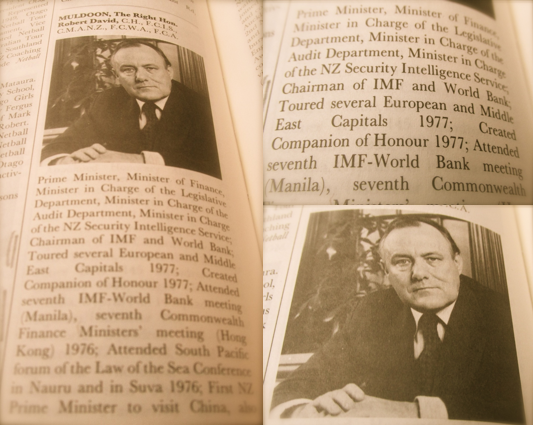
By 1984, New Zealand’s total foreign debt was $12 billion, which primed the state apparatus for coercion to submit to the ‘free market’ policy shocks engineered from abroad and from within.xxviii As with elsewhere around the world, governments struggled with the impacts of the economic warfare devised by the Western Alliance’s 1973-74 Oil Shocks and were coerced to accept ‘free market structural adjustments’ in return for International Monetary Fund (IMF) ‘emergency loans’.xxix
An embattled Muldoon, who had chaired the International Monetary Fund and World Bank from 1979 to 1980, called a snap election on June 14th 1984, despite warnings that such an event amid an imposed freeze prices, wages, interest rates, dividends and the exchange rate would likely trigger a currency attack. Property investor Bob Jones lead the now-defunct New Zealand Party (1983-85) in order to split the vote so that the Labour Party would win the general election in 1984 over the incumbent National Party. Jones’s move was ironic because he established the Capital Club as a political fund-raising mechanism to propel the National Party and his friend Robert Muldoon into power to pass the Property Speculation Tax Repeal Bill. Jones evidently hated the Muldoon’s freeze because it worked as a ‘rent ceiling’. At that time, the confederacy of white supremacist Pākehā Neo-Feudal Ḗlites captured the incoming-Lange-Labour Government in an audacious political-bureaucratic-financial coup to re-set New Zealand onto a Neo-Feudal trajectory. New Zealand’s currency had been speculated against during the election campaign, following shadow finance minister Roger Owen Douglas’s distribution of a paper stating that he would substantially devalue the currency if Labour became the government.xxx The business community knew Douglas’s position, particularly as he was friends with Treasury Official and future president of the Business Round-Table, Roger Kerr, and Alan Gibbs, who set-up Chase-NBA’s N.Z. foreign exchange trading in the early 1970’s .xxxi Indeed, the then-state-owned Bank of New Zealand was among the institutions that had bet against New Zealand’s currency, as Marcia Russell found while producing a documentary series, Revolution, that she turned into a book, Revolution: New Zealand from Fortress to Free Market.xxxii
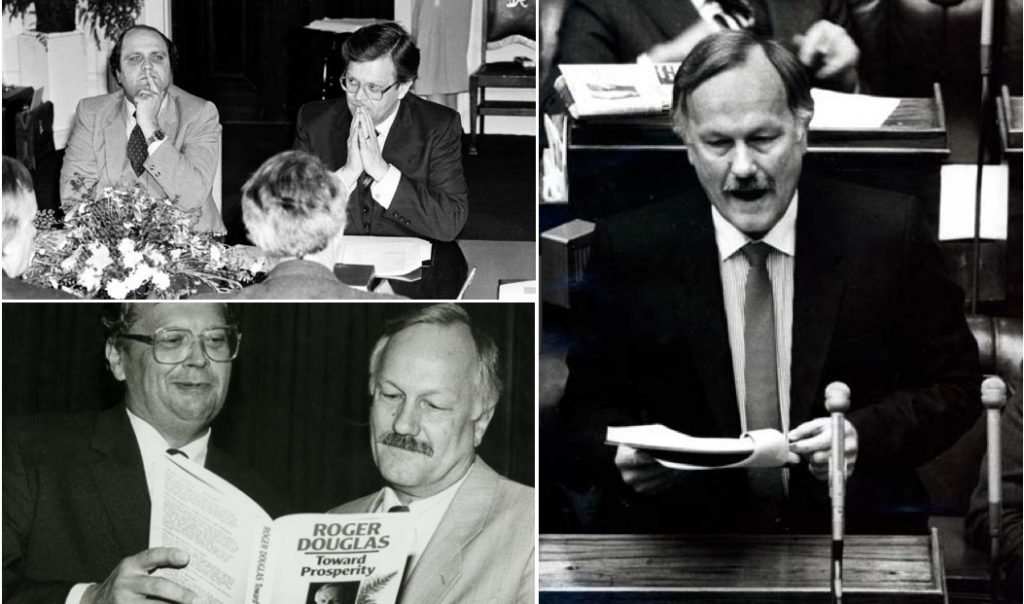
The Governor of the New Zealand Reserve Bank Spencer Russell played his devious part by adding to the emotional atmosphere of crisis. He kept the Reserve Bank closed on the Monday following the election. In keeping with colluding players advancing the game, Russell and Deputy Secretary of Treasury, Bernie Galvin, dined that evening with bankers from the Bankers’ Association at the Le Normandie Restaurant, whose name for New Zealanders conjured World War II history. Normandie, or Normandy, to New Zealanders is most famous for the Allied Forces’ Invasion of Normandy in Northern France in June and July 1944. The bankers were expressing their dark élite humour because the codename for the decisive Battle of Normandy was Operation Overlord. Reserve Bank official Dr. Roderick Deane called his bosses at Le Normandie Restaurant to put them in touch with “certain Ministers” of Muldoon’s cabinet, since the perennially stubborn Muldoon had expressed his own ideas on the six o’clock news about handling the currency crisis, causing the transition of administrations to stall until he capitulated on Tuesday 17 July.
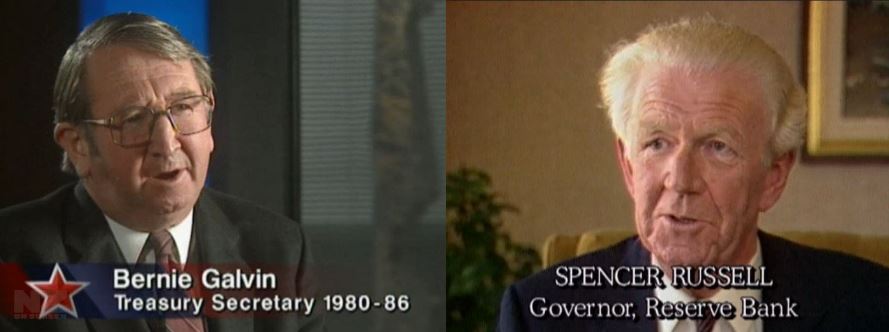
The Reserve Bank and Treasury claimed the month-long speculative attack on the New Zealand dollar ‘forced’ their institutions to borrow the $1.7 billion to prop up the value of the currency.xxxiii In essence, the currency crisis engineered by the Neo-Feudal Confederacy was a coercive mechanism to post ransom notes, with ‘currency speculators’ whom remained ‘anonymous’ with the complicity of the financial authorities so that they could get away with demanding tax-payer funded bailouts of the currency – lest their speculative positions collapsed. Once the Lange Labour Government predictably capitulated, the Lange Administration became captured hostages to stabilize the transforming structures of power and advanced ‘the game’.
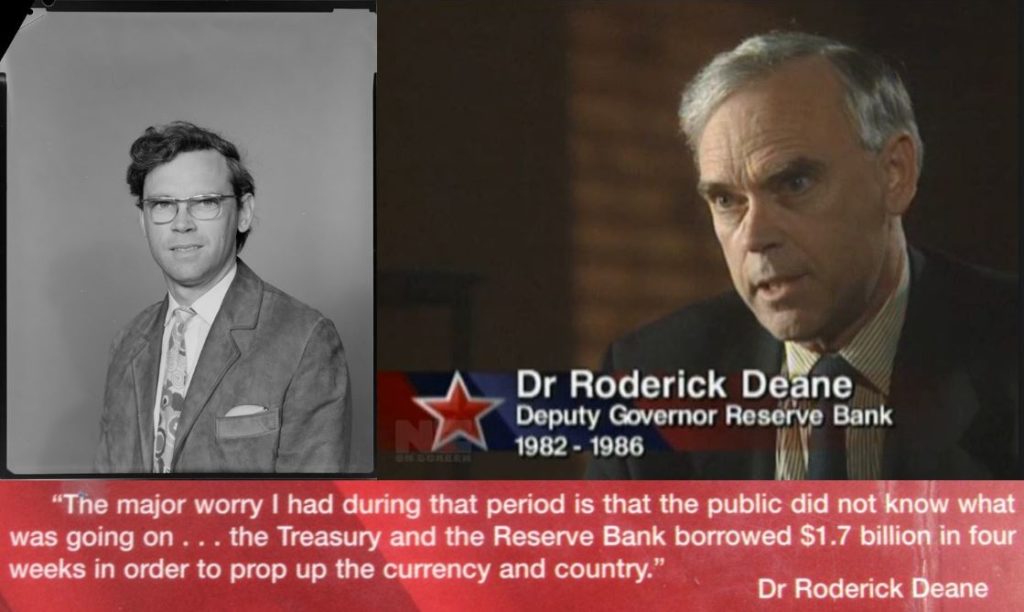
Following this political-financial coup of the Lange Labour Government in July 1984, the head of the Treasury – Finance Minister Roger Douglas – moved to phase two of the planned shock treatments. Controls on prices, wages, credit, dividends, foreign exchange and out-bound capital were lifted.
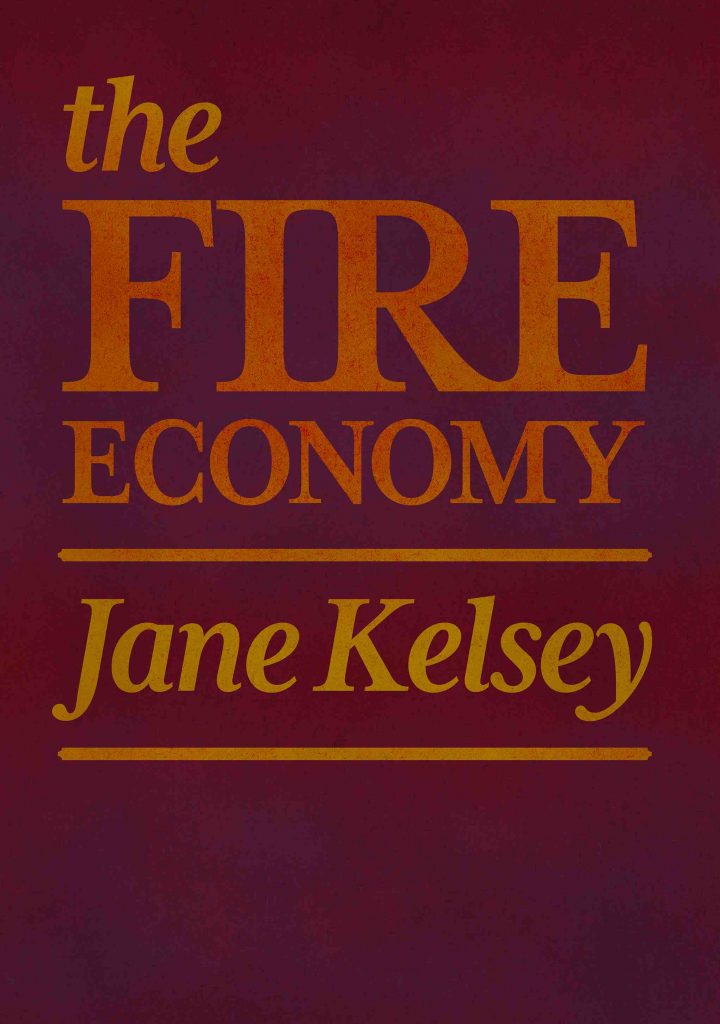
In addition to freeing up controls on the financial system, the Labour-led New Zealand Government (1984-1990) pursued more shock therapies. The Labour Government did so with a blitzkrieg strategy to overwhelm and gain submission of whole sectors of society – in collusion with key big business beneficiaries, as Jane Kelsey describes Roger Douglas’s modus operandi in her 2015 book, The FIRE Economy, which locates the former Lange Government finance minister’s stealth in the kind of Shock Doctrine crisis scenarios described by Klein in The Shock Doctrine. The Lange-Labour Government removed subsidies that insulated the farming sector, tariffs on imports that sheltered domestic producers from cheaper-produced products made overseas, and progressively raised statutory approval thresholds for foreign investment, thereby paving the way for foreign capital to buy up New Zealand businesses, land and mining licenses. Moreover, the Labour Government corporatized public sector commercial trading entities, infrastructure and services, meaning business models were applied to the public sector under the rubric of introducing efficiencies. The covert intention was to inflict mass lay-offs and ready the public institutions for privatization, called ‘state asset sales’, to create a hi-tech toll-booth economy loaded with debt, taxes, fees, fines and Neo-Feudal fiefdoms.
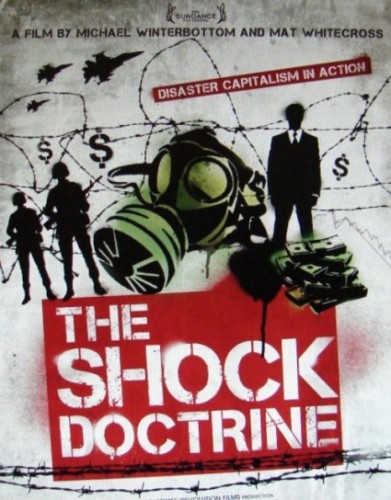
In this epic strategic sabotage of industry, industrial-scale job cuts were inflicted between 1987 and 1995. In the private sector, manufacturing employment dropped by 30%, while in the public sector, 62,100 people were sacked by the state.xxxiv In 1983, the unemployment rate was 6% of the workforce, peaked at 16 percent in December 1992 and has averaged 6% from 1983 to 2019.[6] It had been only 1% in 1971. By liberalizing controls over the financial system in mid-1984, the Neo-Feudal Confederacy opted to favour high capital mobility and stabilize the currency, while scuttling achieving full-employment at a time when unemployment was already over 250,000, out of 3.3 million people.xxi Their callous intent was drive unemployment upward, so that the large-scale visible poverty would weaken workers’ wage and salary pay bargaining power, and therefore, deliver bigger profits for big businesses – as Alister Barry’s 2002 documentary, In a Land of Plenty: The Story of Unemployment in New Zealand revealed.
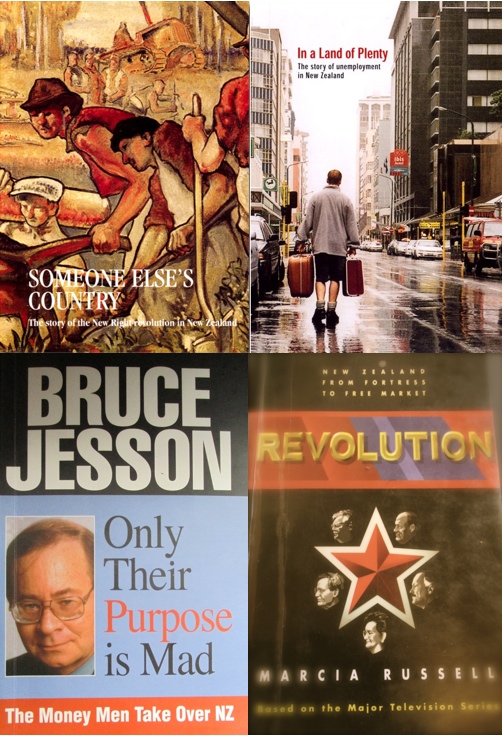
By weakening resistance to the siege through inflicting high mass unemployment, widespread enterprise failures and cross-sector strategic sabotage of industries – high inflation would eventually come down. The Neo-Feudal Capitalist Confederacy knew if they stayed the course in the economic warfare plan, they would eventually be rewarded with cheaper credit supplied by international and domestic banks. With the promise of cheaper credit for use as capital to buy stakes in the ‘Switzerland of the South Pacific’ Utopia, the Confederacy colluded to forge a Neo-Feudal jurisdiction characterized by an asymmetric economy featuring high asset-side wealth inflation, low cost-side inflation and an exploitable, brainwashed host population of Neo-Feudal Tax Slave Serfs – as The Snoopman showed in “Discretionary Idleness: Structural Unemployment as a Shock Doctrine Economic Warfare Tool in Neo-Colonial New Zealand”.
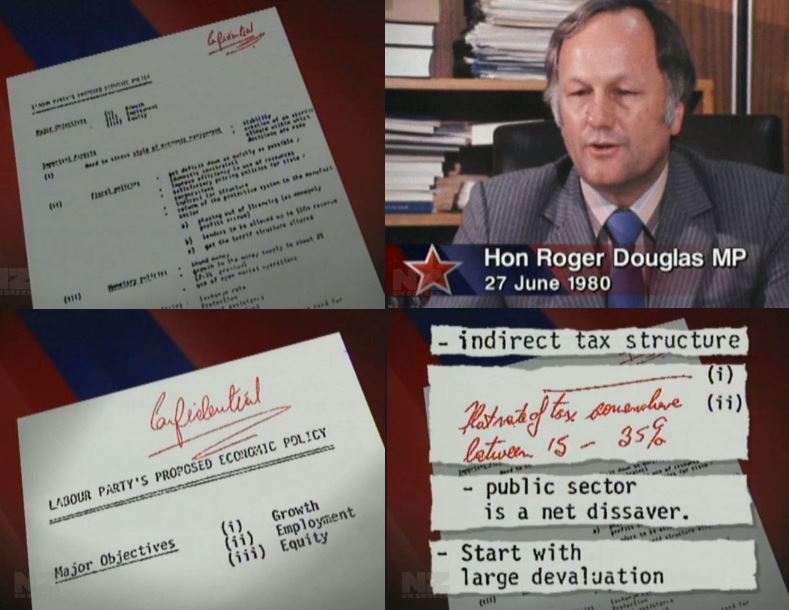
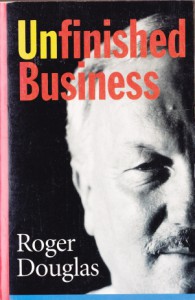
At a Mont Pèlerin Society conference in Christchurch in 1989, Mont Pèlerin Puppet Actor Sir Roger Douglas bragged to the 400 attendees that his shock therapy modus operandi to overwhelm multiple sectors by casting himself as a fast-moving target.xxiv Reserve Bank Shock Doctor, Roderick Deane, was among the attendees. In his summing up words for the 1996 documentary series Revolution: The New Country, the Douglas, said:
“In politics, it’s the ‘Art of the Possible. If you’ve got an opportunity and you want to undertake reform, do it.”
In effect, the former Finance Minister was admitting that the Neo-Feudal Siege of Wellington and New Zealand was not a mandated policy platform. Packaged within this admission was also a reference to his bragging 1989 Mont Pèlerin speech in Christchurch, which he wrote about in ‘Chapter 10: The Art of the Possible’ of his 1993 book, Unfinished Business. Roger Douglas’s modus operandi was one Neo-Feudal cog in an epic, brazen political conspiracy.
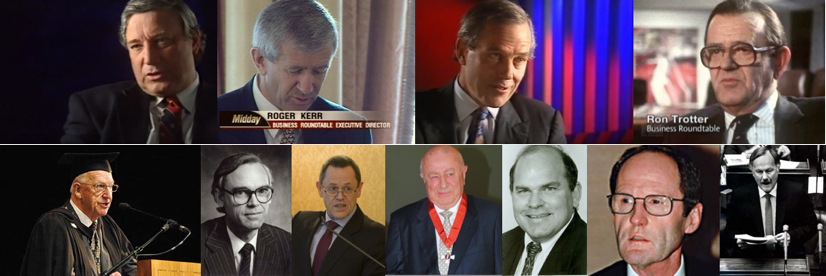
🎯
The Fletcher Connection »»
At fire sale prices, Fletcher Challenge bought resources that generations of New Zealand Tax Herds had paid for, built and run on lands stolen, swindled and stealthily wrested off Māori. These state assets included: Petrocorp for $801 million, a $254 million stake in Maui Gas; NZ Liquid Fuels for $203 million, Synfuels for $121 million, a $119 million stake in Taranaki Petroleum mining licenses, $687 million paid for Rural bank, $262 million in Forest cutting rights. The Forestry Corporation of New Zealand, or ForestCorp, was sold in 1996 for $1.6 billion to Fletcher Challenge (37.5%), Brierley Investments (25%), and a Chinese company, Citifor Inc (37.5%)
The Deep Rockefeller-Rothschild Dynasties Connection
It turns out that the Fletcher Building consortium is 54%-owned by three transnational banks. These three transnational banks are: HSBC, which owns a 26.48% stake; JP Morgan Chase Bank, controls 16.15%; CitiBank holds 11.46% of Fletcher stocks.xxxv
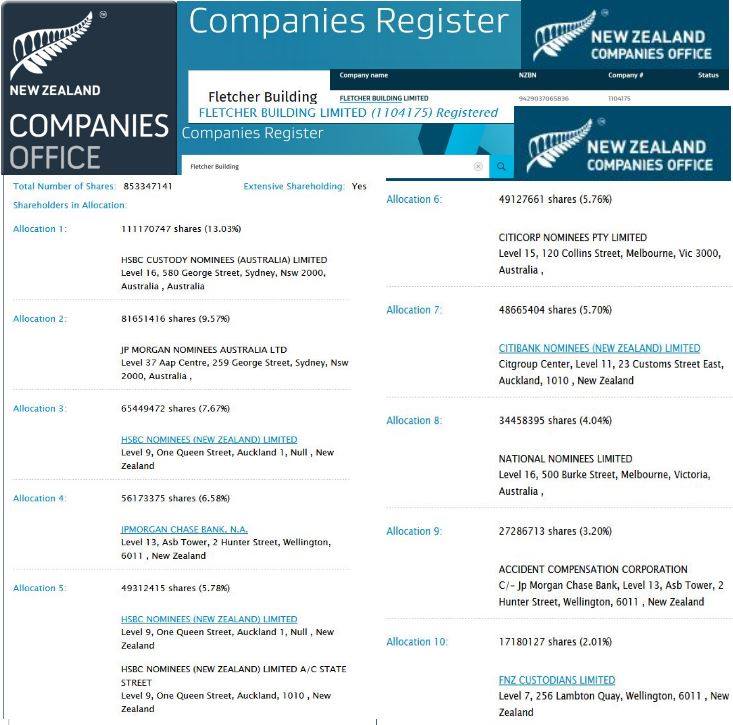
These three banks – JP Morgan Chase, CitiBank, and HSBC – that own a stake in Fletcher Building are among the corporate members of at least two of the world’s global-policy shaping think-tanks responsible for re-setting the world onto an economic warfare trajectory with Neo-Feudal ‘market economies’. Three of these global-policy shaping think-tanks are the Trilateral Commission (T), the Council on Foreign Relations (CFR) and the Bilderberg Group (B): JP Morgan Chase (T, CFR, B), CitiBank/CitiCorp (CFR, B), and HSBC (T, B).xxxvi
All three banks – JP Morgan Chase, CitiBank, and HSBC – required industrial-scale bail-outs following the Global Financial Crisis of 2007-2008, and gained from access to cheap Federal Reserve credit to accumulate more wealth and have recklessly contributed to blowing a bigger financial bubble.
Underpinning the JP Morgan Chase Bank stake is the deepest Rockefeller-Rothschilds Dynasties Connection. On September 13th 2000, JP Morgan Bank and the David Rockefeller-controlled Chase Manhattan Bank announced their merger to form JPMorgan Chase.xxxvii This merger represented a deepening fusion between the Rothschilds and Rockefellers because it was the Rothschilds that bankrolled the Robber Barrons – John Pierpont Morgan, John D. Rockefeller and railroad magnate, Edward H. Harriman – in the post-American Civil War era, among others.
In his seminal 1991 book, The Secrets of the Federal Reserve: The London Connection, Eustace Mullins found that the House of Rothschild’s principle agents for gaining control of strategic resources in the United States was through August Belmont (formerly known as August Schoenberg), J. P. Morgan and the partners of the private bank, Kuhn, Loeb Company. It turns out that John D. Rockefeller was financed through private banking house Kuhn Loeb & Company, and therefore the Rockefeller empire was initially bankrolled by the House of Rothschild through this conduit. Similarly, the banking and industrial conglomerate, JP Morgan and Company, was a subsidiary of Junius S. Morgan of London and N.M Rothschild Company of London, as well as Kuhn, Loeb Company, which was run by Jacob Henry Schiff (born Jakob Heinrich Schiff, 1847–1920), who had bought into the partnership with Rothschild funds.xxxviii After J.P. Morgan died in 1913, it was found that he only owned a 17% stake in the empire.xxxix
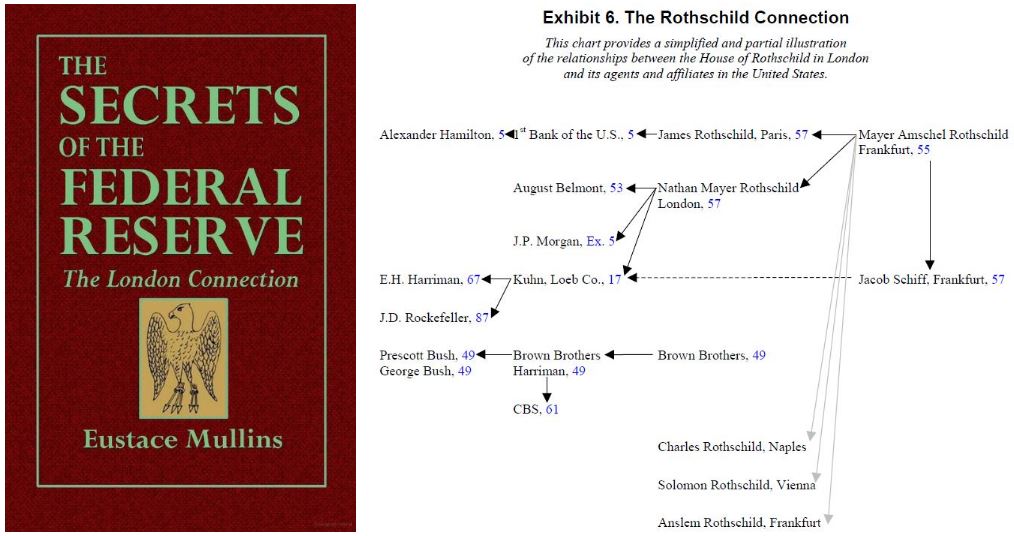
In 1914, when the initial 203,053 shares were allocated for the privately owned U.S. Federal Reserve banking cartel, 40% of the Federal Reserve Bank of New York stocks were bought by five banks with the Rocker-Stillman banking dynasties controlling the nearly a quarter. The big five controlling blocks in the Federal Reserve Bank of New York stocks were: the Rockefeller-Stillman orbit controlled National City Bank, holding 30,000 shares, or almost 10%; the Morgan-Schiff-Harriman-Warburg controlled National Bank of Commerce, holding 21,000 shares; the Morgan-Baker controlled First National City Bank, holding 15,000 shares; and the Stillman-Rockefeller controlled Hanover National Bank, holding 10,300 shares; and the Rockefeller-Stillman controlled Chase National Bank, holding 6,000 shares.xl
Mullins found that by the early 1960s, five London based merchant banks controlled the US Federal Reserve’s dominant bank, the Federal Reserve Bank of New York, and were among 17 exclusive banks that are permitted to operate as merchant bankers in the square mile financial district, privately-owned by the Municipal City of London Corporation. Those five were: N.M. Rothschild, Schroder Bank, Lazard Brothers, and Morgan Grenfell, the London Branch of the House of Morgan, and Brown Shipley Company, the London branch of Brown Brothers Harriman.
In 2012, the business press reported that the Rothschilds were buying into Rockefellers’ wealth and asset management business with the spin that the merger into a Multi-Family Office (MFO) was “a long-sought foothold in the United States.”xli The Rockefeller Dynasty sold a 37 per cent stake in its own IT platform, Rockit Command – launched in 2000 to manage the information of what amounts to more than 10,000 clients – to Lord Jacob Rothschild’s RIT Capital Partners.xlii
🎯
The Fletcher Connection »»
As we have learned, the Fletcher Dynasty were privy to discussions among industrialists, bankers, and political elites, when James Fletcher I attended the inaugural International Industrialists Conference in San Francisco in 1957. The discussions included participants such as the oil and banking Rockefeller Dynasty, the Swedish Wallenberg banking dynasty and the Bechtel engineering and construction dynasty, whom were part of a Neo-Feudal Confederacy creating formidable interlocked transnational cartels.
Next, we will climb down into the ‘Fletcher-Rockefeller-Rothschild Dynasties Rabbit Hole ’, and see this exclusive industrialists group was connected by linked elites, corporate memberships and political representatives to a global policy-shaping think-tankerati that included the Council on Foreign Relations, the Bilderberg Group and the Trilateral Commission. These think-tanks, their members and their affiliated institutions engineered crises of national and global proportions, and formulated broad policies, influenced elites and captured governments. The Fletcher Dynasty actively participated in these machinations to inflict a destabilization of New Zealand economy, sabotage industry and takeover smaller firms.
The Fletcher-Rockefeller-Rothschild Dynasties Rabbit Hole
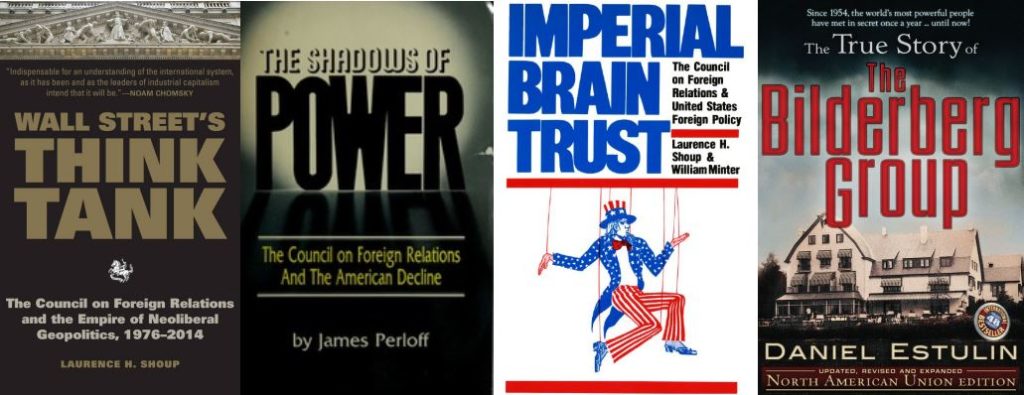
The impetus for this re-set of the New Zealand Realm and the rest of the world onto a Neo-Feudal trajectory, came from the then-North Atlantic Neo-Feudal Capitalist Class, who faced several major crises in the mid-to-late 1960s. These calamities were a structural crisis of Declining Profit Rates for transnational and state-located corporations, a Crisis of Democracy presented by the numerous 1960s Peoples’ Movements and demands from a ‘Developmentalist Movement’ in the ‘Third’ and ‘Second World’ countries for Western technologies in fair return for the resources supplied to rebuild Western Europe and Japan following World War II.
The North Atlantic banking dynasties that owned the Federal Reserve cartel needed to reinvigorate the U.S. military-backed FED dollar, since ‘currency speculators’ had been challenging its defacto world reserve currency status since the late-1960s, and its value pegged to gold at $35 per Troy ounce.xliii Consequently Rockefeller’s political puppet, President Millhouse Nixon, removed the Fed Dollar from the gold standard on August 15 1971. To counter these crises, the North Atlantic Capitalist Class developed a ‘free market’ economic warfare framework to transform the world, as articulated in the documentary Requiem for an American Dream featuring long-time critique of U.S. Imperialism, Professor Noam Chomsky.xliv
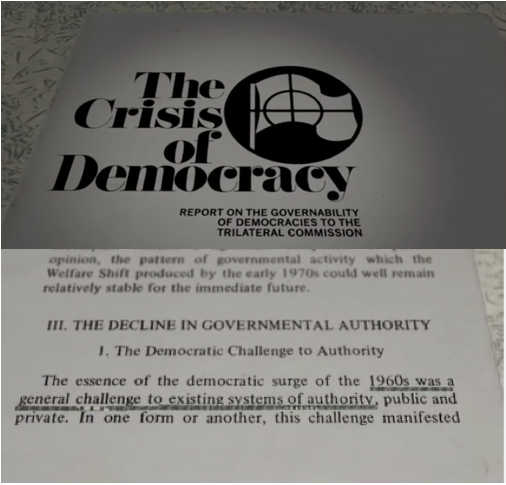
The secret blueprint sponsored by the ‘imperial brain trust’ – dubbed the ‘1980s Project’ – was first formulated between 1971-1973 at the David Rockefeller-chaired Council on Foreign Relations (CFR) – as Laurence Shoup and William Minter revealed in their 1977 book, Imperial Brain Trust: The Council on Foreign Relations and United States Foreign Policy.xlv The New York-based global policy shaping think-tank planned for the spread of Neo-Feudal ‘free markets’ by working in ‘1980’s Project’ study groups for the rest of the 1970s. Their malicious purpose was to reduce the material wealth of mass populaces so that they would be less able to assert their political independence and, therefore, be hindered in their efforts to build autonomous, resilient communities.xlvi
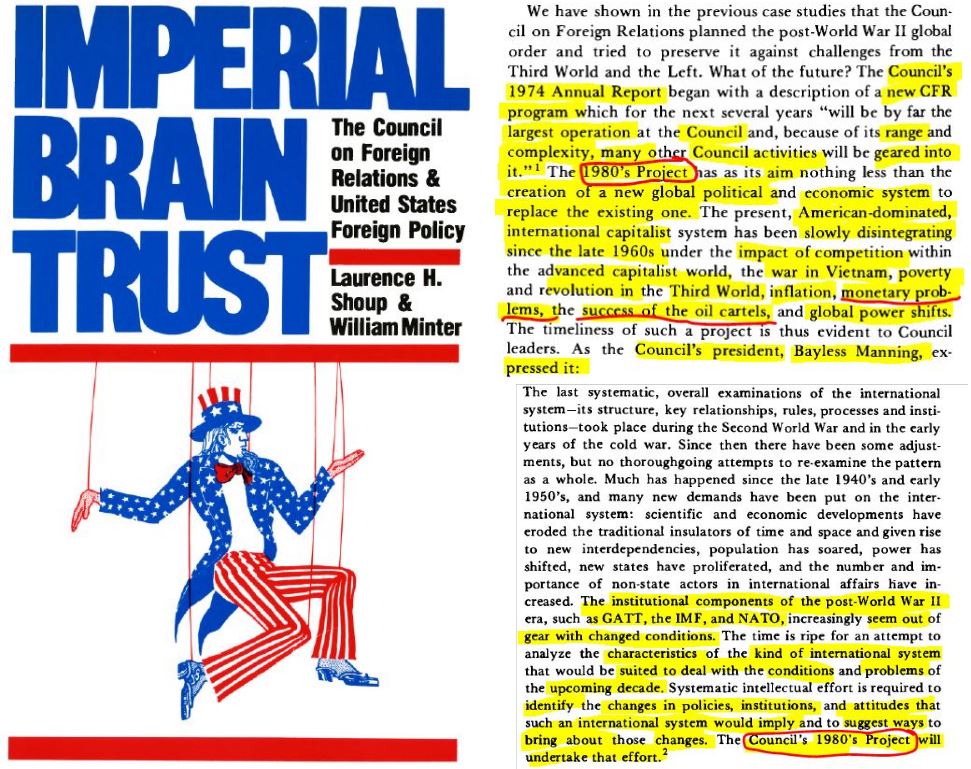
To reinvigorate the Federal Reserve’s embattled dollar, the ‘Dark Prince’ – Henry Kissinger – hatched the idea of supplying U.S. manufactured arms to ‘client states’, whom would serve America’s imperial aims. In a May 1972 meeting in Tehran, Mohammad Reza Pahlavi – better known as the Shah of Iran – was induced to buy American Made weaponry by President Nixon and Henry Kissinger. But, the Shah of Iran lacked the cash. The Rockefeller-Kissinger-Bilderberger Nexus worked out that they needed a trigger event that would work as a cover for the Shah of Iran to hike oil prices so that he could afford his military spending.xlvii
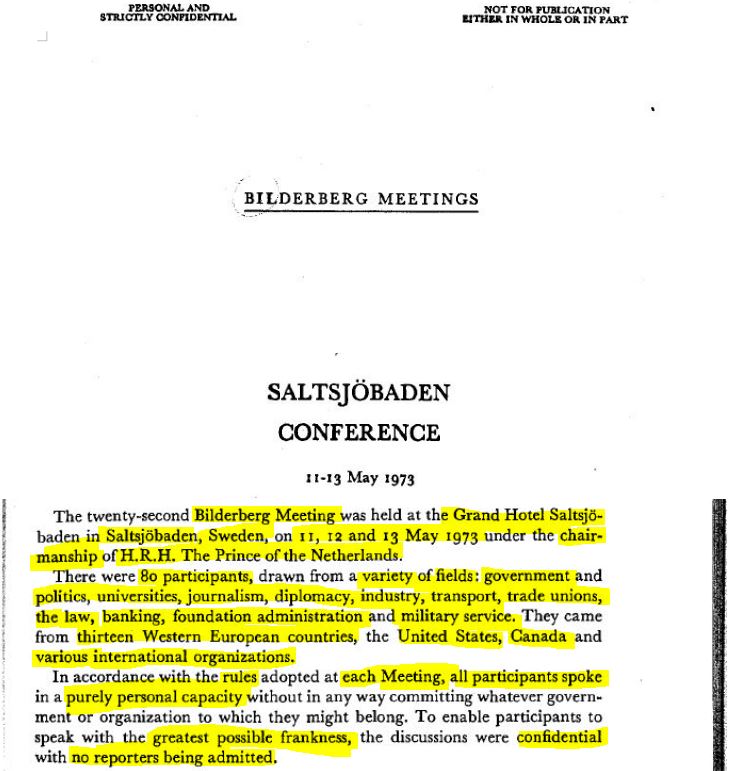
One year later, in May 1973, the likely impacts of the oil price shocks in the pipeline were discussed at the secretive Bilderberg Foundation meeting on the island resort of Saltsjöbaden, owned by the Swedish Wallenberg banking dynasty. Walter Levy, who was a New York-based oil consultant and who during World War II headed the petroleum section of the Office of Strategic Services, the forerunner of the CIA, delivered a paper on oil.xlviii Levy presented a scenario wherein the world faced serious challenges to managing the world’s energy consumption, capacity for supply and control of resources, particularly as they related to the potential to “undermine the world monetary system.” Two participants referred to a White House and State Department energy expert, James Akins, who evidently revised his earlier estimate of $5 a barrel and that future energy prices would be in the range of U.S.FED$10-$12.50 a barrel.xlix In September 1973, the month prior to the Oil Price Shocks-triggering Yom Kippur War, oil was U.S.FED$2.59 per barrel and jumped to U.S.FED$11.56 per barrel in January 1974.l
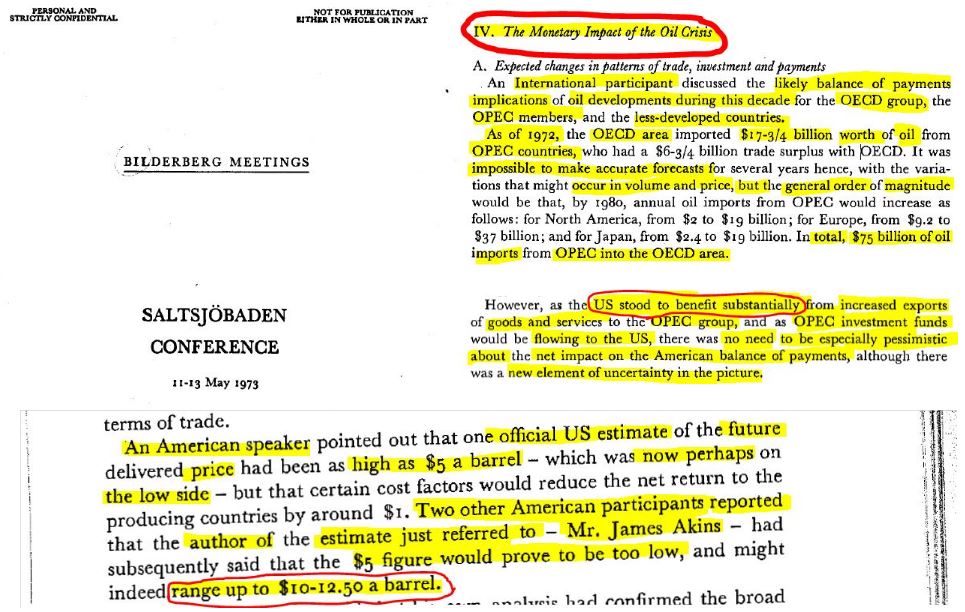
Kissinger, with the assistance of ‘back channels’ in London, orchestrated the Yom Kippur War of October 1973 by deceiving the Egyptians, Syrians and Israelis about one another’s agendas. The House of Saud’s King Faisal had already expressed his displeasure to Kissinger and other U.S. officials about U.S. armaments supplies to Israel, and warned of an OPEC oil embargo.li Intelligence confirmed a build-up to war was underway. Kissinger persuaded Nixon to appointed him as U.S. Secretary of State. The ‘Dark Prince’ played Ares, the mythical Greek God of War, and manipulated Egypt and Syria into invading Israel on October 6 1973.
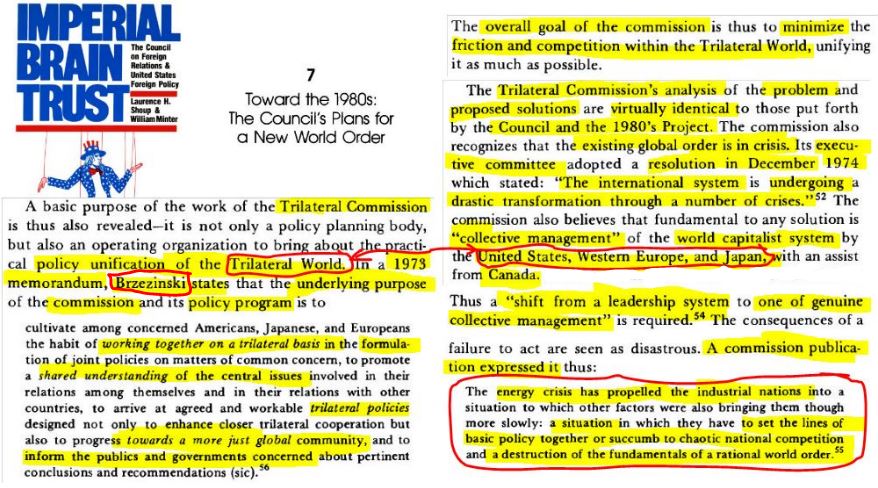
Key insiders from Washington, New York and London had correctly calculated that Arab oil-producing countries would react to U.S. support of Israel in the war by imposing an oil embargo on the United States. The ensuing oil embargoes on the US and the Netherlands (since Rotterdam was a major oil port for western Europe), within ten days of the invasion and the accompanying increases in oil prices, meant that the much of the world was forced to pay 400% more for petroleum, which was traded in U.S. dollars, amid the apparent oil scarcity. Conspicuously, the Shah of Iran ‘boycotted the boycott’ and increased oil output to the U.S. and British ports to counter the ‘scarcity’. In turn, this meant that Wall Street banks and most especially Rockefeller’s racketeering Chase Manhattan Bank, made enormous profits from ‘Petro-Dollars’. Chase Manhattan Bank was the Iranian government’s bank, as well as the bank of the National Iranian Oil Company and the Shah’s family bank, and the Pahlavi Foundation’s bank.

In his book, A Century of War: Anglo-American Oil Politics and the New World Order, William Engdahl, who found a copy of the 1973 Saltsjöbaden Bilderberg Meeting Report in a Paris bookshop, argued that the 1970s ‘energy crisis’ served as a pretext for the Wall Street-Washington-City of London Complex to increase the cost of credit to 20% (amid runaway inflation). Federal Reserve Chairman Paul Volcker achieved this 20% hike for Federal Reserve’s credit through restricting the currency supply, ostensibly to control inflation, as the documentary Money for Nothing: Inside the Federal Reserve shows. Meanwhile, exports plummeted as families’, businesses’, governments’ purchasing power dropped, production costs for all countries soared, and states ‘borrowed’ from the central banks’ central bank, the IMF, because tax revenues fell as exporters’ sales sunk and whole economies stagnated. When combined with the underlying Bilderberg Nexus-induced economic crisis, a world debt crisis emerged as interest costs on IMF emergency ‘loans’ soared in this epic strategic sabotage of industry. Through these structural racketeering machinations, an epic debt bubble blew into the ‘World Debt Crisis’ of 1982.
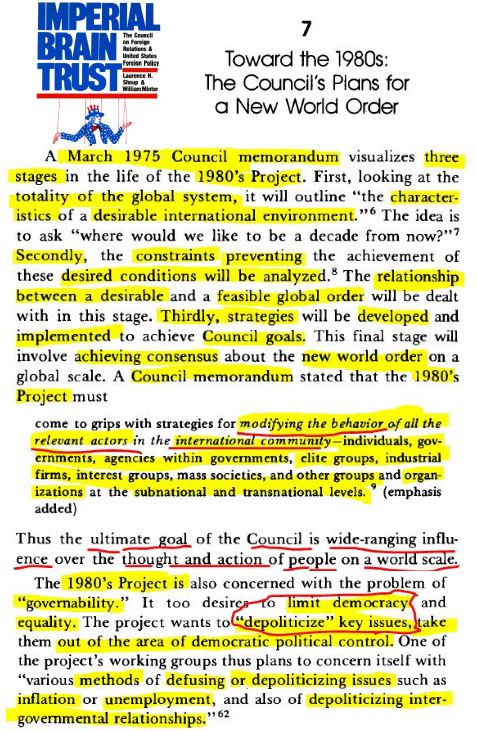
Thus, the ‘deep state’ oil price shocks laid the groundwork for further Neo-Feudal ‘free market’ economic shock therapies’, which were themselves mechanisms of coercion, because all governments and sectors of society were thrown further into crisis. Everyone suffered, except key insiders, who became richer and accumulated more power – economically, politically and militarily.
🎯
The Fletcher Connection »»
It is therefore an intriguing pattern to find that Jim Fletcher’s recollection in the biography, Made in New Zealand: The Story of Jim Fletcher, about hearing the OPEC representative, Sheik Yamani, discuss oil prices before the first oil price shocks, at the 1973 International Industrial Conference.lxx When it is recalled that Marcus Wallenberg – who had advised the N.Z. Government on pulp and paper in the late 1940s when Fletcher Holdings was forming Tasman Pulp & Paper with the Crown – his presence at the May 1973 Bilderberg Meeting at the Swedish Wallenberg banking dynasty’s Grand Hotel Saltsjöbaden, shows that Wallenberg was among a cross-over of professional élites, puppet politicians and super-rich oligarchs bending the world for their own purposes. Wallenberg had, after all, attended the International Industrial Conferences with Jim Fletcher. Other participants at the May 1973 Bilderberg Meeting were: Prince Bernhard of the Netherlands; French Baron Edmond De Rothschild of the war financing Rothschild banking dynasty; Fiat Chairman, Giovanni Agnelli of Italy; future architect of the Soviet–Afghan War (1979-1989) and co-founder of the Trilateral Commission, Zbigniew Brzezinski; CFR’s Foreign Affairs magazine editor and key architect of the Vietnam War, William Bundy; Executive Director of Public Affairs TV, Bill Moyers, Sir Eric Roll, of S.G. Warburg Bank; and BP Chairman, Lord Greenhill.lii
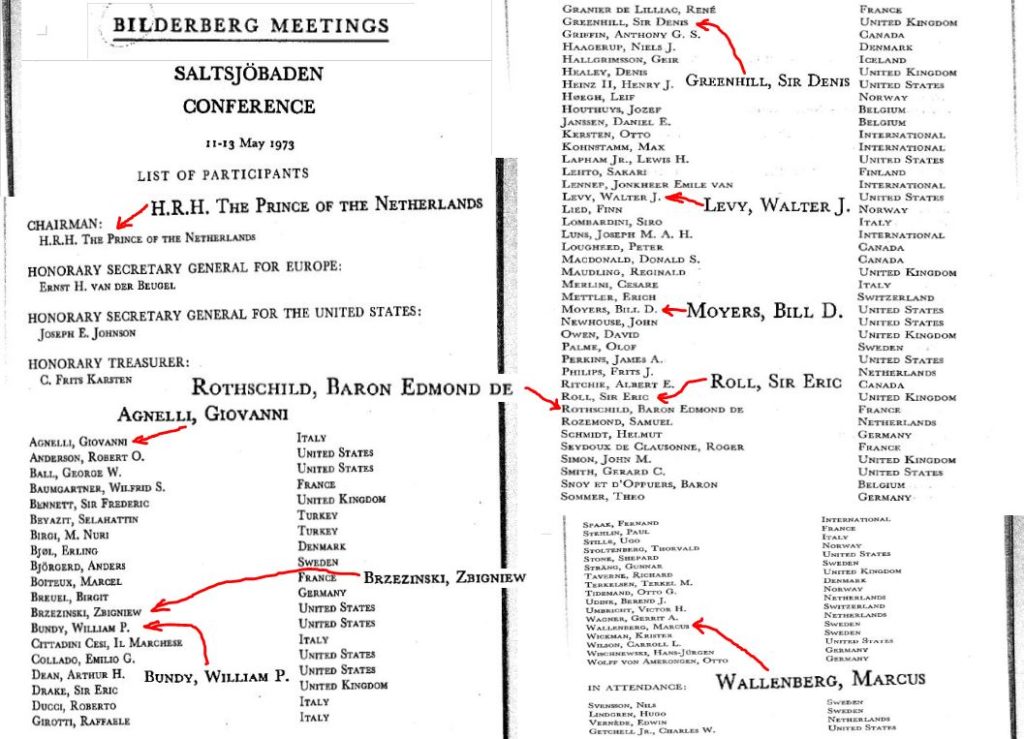
In other words, the Fletcher Dynasty were in the orbit of those privy to machinations to engineer the 1973-74 Oil Price Shocks before they occurred, with the Old Sir James’ son Jim on the policy board of these conferences in San Francisco comprising 500 of the planet’s leading industrialists, feudalists and bankers – from 1969 onward.
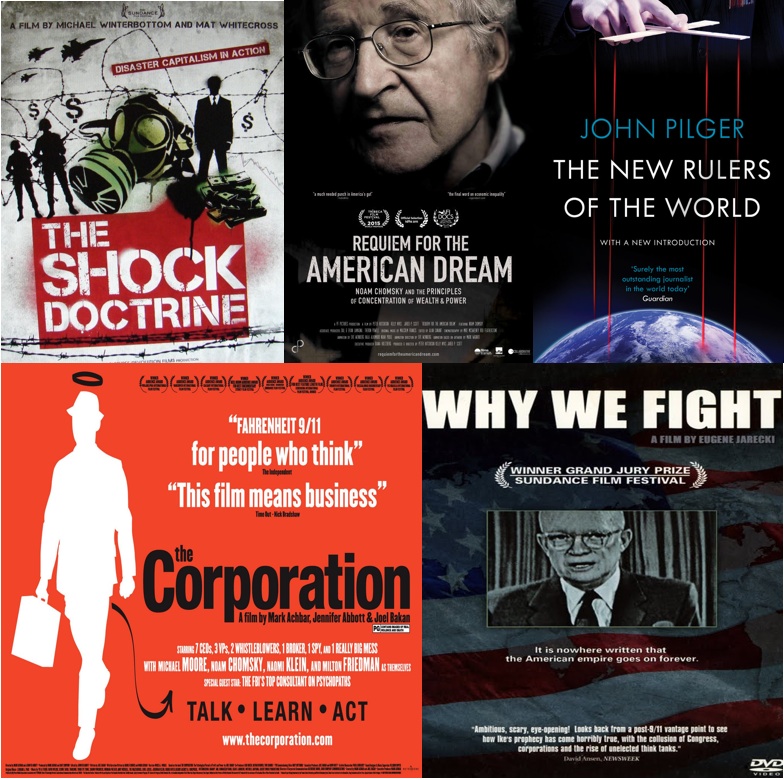
As The Snoopman mentioned earlier, the infliction of those oil price hikes is of relevance to Ihumātao because these machinations of the Rockefeller-Kissinger-Bilderberger Nexus were a major re-set for the world and New Zealand. The Oil Price Shocks made New Zealand vulnerable to the corporate siege in mid-1984, that set the Realm on an economic warfare trajectory that produced a housing crisis, which led to the rural land at Ihumātao being designated as a Special Housing Area in a city deemed to have attained the status of a Global City.
From Colonial Town to Global City in a Switzerland of the South Pacific
The purpose of forging Global Cities is to support the huge geographically dispersed transnational corporations, such as Fletcher Building Limited, that require jurisdictions to facilitate high capital mobility, organize public debt-funded infrastructure, and accommodate large pools of excess labour – as Saskia Sassen outlined in “The Global City: introducing a Concept” (along with other academics).liii To this end, the Neo-Feudal institutions and individuals behind the corporate siege of New Zealand rammed through policies, processes and protocols to create structural growth pressures so that Auckland City would eventually attain Global City status. By 2015, Auckland City became ranked as a ‘Global City’ in 37th place in a Top 40 Global Cities Survey that cast Auckland as a safe-haven for 557 Ultra High Net-Worth Individuals with investible wealth of $30 million or more, as published in Frank Knight Capital Management’s Wealth Report.liv
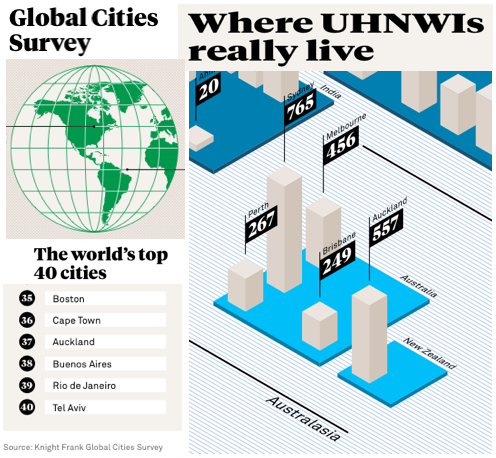
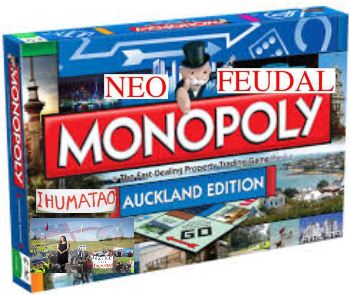
By August 2016, the ‘City of Sails’ recorded a jump in average house prices to $1,000,000 from $500,000 ten years earlier, which meant that house prices had grown at an exponential rate of 7% per year over a decade. Applying the doubling time concept at the 7% annual growth rate – and with all factors staying constant – Auckland’s average house price was set to double again in just 5 years, reaching $2m in August 2021, and $8m in May 2025 – if all other factors had remained constant – as The Snoopman explained in his referenced primer, “In a Land of Shock Therapies: Part 1 – New Zealand as a Crisis-Ridden Theme Park”.
The primary driver of these compounding property prices are the machinations of the cartelized banking industry, including the majority bank owners of Fletcher Building – HSBC, JP Morgan Chase and Citbank – whom all have commercial and retail banks in their global operations. The banking industry maintains a structural scarcity over cash, with the active participation of the New Zealand Crown through the Reserve Bank and the Treasury. Cash only constitutes about 1-3 per cent of the total, meaning the other 97-99 per cent of the currency supply is borrowed into existence as transaction specific credit.lv Indeed, the dirty secret of banking is that bank ‘loans’ are actually manufactured credit funds borrowed into existencelvi and this manufactured credit is the single major source of currency expansion in New Zealand, as senior economic analyst at the Reserve Bank of New Zealand, Gillian Lawrence, explained in a Reserve Bank bulletin in 2008, entitled “The Reserve Bank, private sector banks and the creation of money and credit”.lvii Lawrence stated:
“By far the largest share of money – 80 percent or more, depending on the measure – is created by private sector institutions. For simplicity, we use ‘bank’ to refer to any institution that creates money or credit.” Gillian Lawrencelviii
In this way, interest is not “the price of money” – since no money that previously existed is lent. Rather, interest represents a rent or the fee for supplying manufactured credit fraudulently marketed as ‘loans’. Therefore, the banking industry’s windfall profits accumulated off the interest collections is extortionist.lix Particularly, as many New Zealanders are forced to compete in a low-wage economy for the scarce cash to ‘repay’ the conjured credit. This competition is intensified because the interest component is not created along with the principle amount of credit funds borrowed into existence. Consequently, each generation is compelled to sell homes and businesses at ever higher values just to break even because of the interest! In other words, the Crown is actively involved in the supervision of a cartel that restrains trade through the restriction of supply of an essential resource – cash. This restriction on the cash would otherwise be unnecessary in a de-cartelized, positive money economy.lx
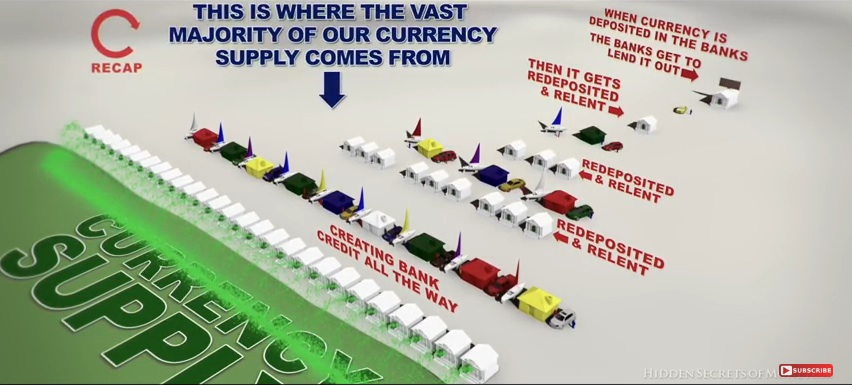
🎯
The Fletcher Connection »»
The result is that by the time SOUL was headed to the Environment Court in 2018 to contest the Fletcher Building cartel’s planned housing development, New Zealand gained the crisis-indicating ranking of being the most unaffordable place to live in the world – as London-based Bilderberger Group mouth-piece, The Economist, magazine reported in March 2017.lxi Indeed, the bottom 1% or 42,000, were so poor they were classified as homeless,lxii while the top 10 percentile of the 1% were so rich, the National Business Review reported their wealth to be $55.84 billion.lxiii
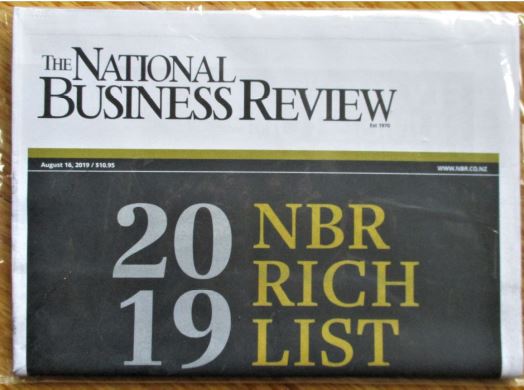
Ironically, the contested Ōruarangi Block housing development at Ihumātao was marketed as one project to alleviate Auckland’s acute housing supply crisis. The 33-hectare Ōruarangi Block gained rapid approval because the land was re-designated as a Special Housing Area by the Key Ministry Cabinet on 1 July 2014, with the support of the Auckland Council’s Housing Projects Office, the Auckland Council Development Committee and Auckland City Councillors.lxiv
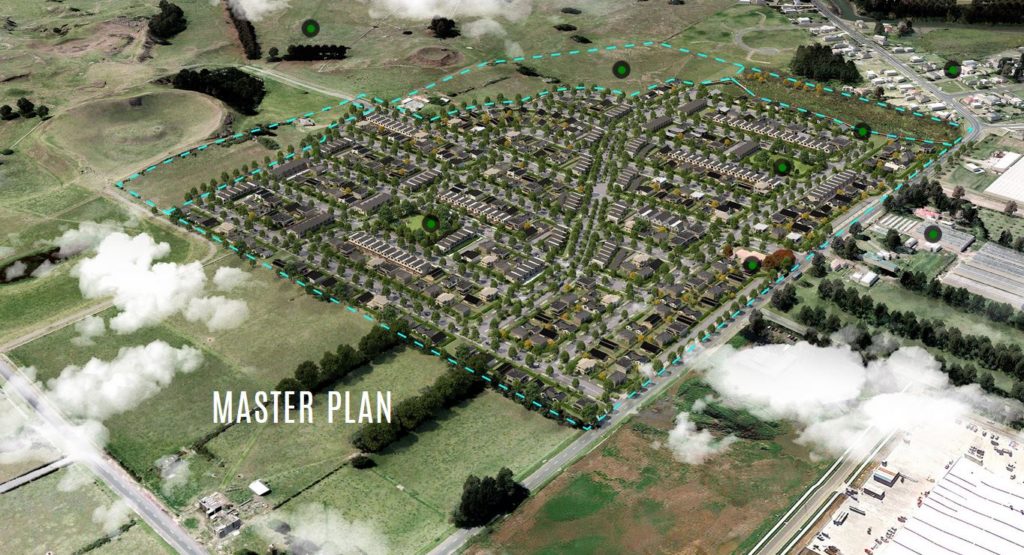
The Special Housing Area is part of the Auckland Council’s Unitary Plan initiative to increase the city’s housing supply. Under the Unitary Plan, rural land, suburban commercial properties and urban real estate were re-designated with higher housing intensity thresholds. The Plan allowed for more high-rise and low-rise apartments, high-density housing developments and infill suburban dwellings. To alleviate the housing shortage, an ‘Auckland Housing Accord’ was signed between the Auckland ‘Super City’ Council and the New Zealand Central Government in October 2013, that set a target for building 39,000 houses over 3 years, or an average of 13,000 houses per year.lxv The Auckland Council’s ‘Housing Action Plan’ also set this arbitrary target of 13,000 houses to be built every year for 30 years, or 390,000 houses, evidently to meet estimates of Auckland’s projected population growth.lxvi At the time, Auckland’s mayor, Len Brown, stated the Unitary Plan was the final “piece on the jigsaw puzzle” to consolidate Auckland’s 13 council wards into one ‘Super City’, which involved rolling 13 plans from 13 previous councils.lxvii In other words, the Unitary Plan was a Global Cities move by the Rich White Old Boys Network.
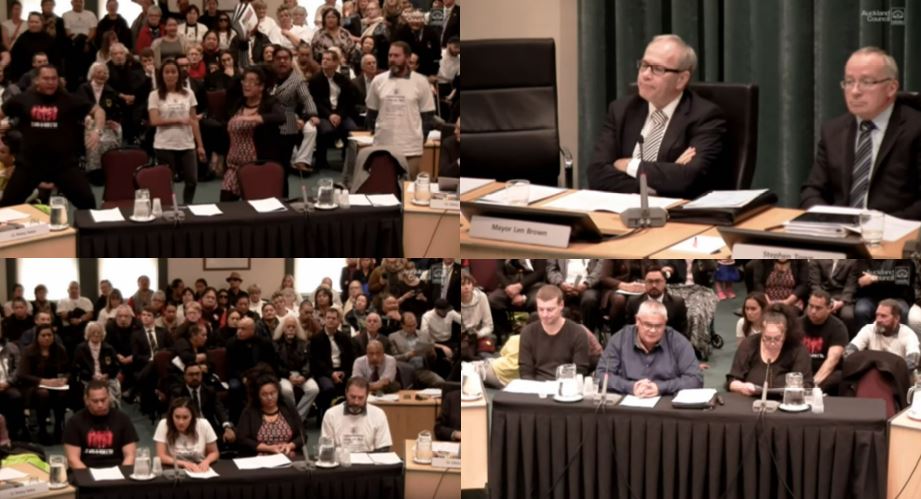
To get this Ōruarangi development at Ihumātao through a significant regulatory hoop, a joint waiver was required by two Key Ministry Crown Ministers in early September 2014 to over-ride breaches to the Overseas Investment Act of 2005. The Wallace-Blackwell Family company, Gavin H Wallace Limited, owner of ‘the Wallace Block’ – as the highly contested land at Ihumātao is locally known – failed to advertise the farm land on the open market prior to sale to the transnational construction company, Fletcher Building.lxviii
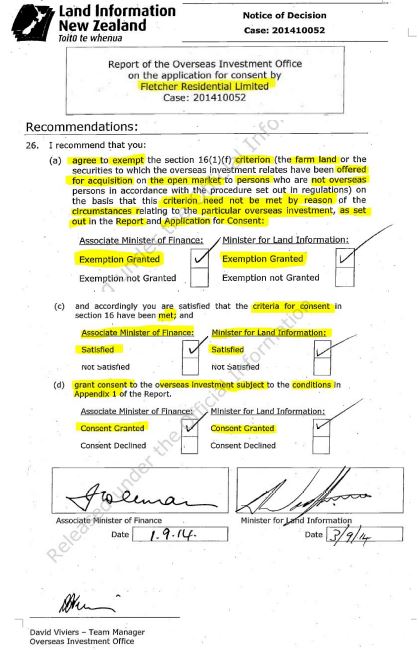
It is, therefore, ironic that when the disputed land at Ihumātao was originally lost in 1863-1866 period in the midst of what was, in fact, the New Zealand Masonic Revolutionary Warlxix – the land was far better advertised. In July and August of 2014, when it was advertised in a couple of local newspapers and on TradeMe, the adverts failed to state any identifying location numbers such as the street, lot or property title numbers.
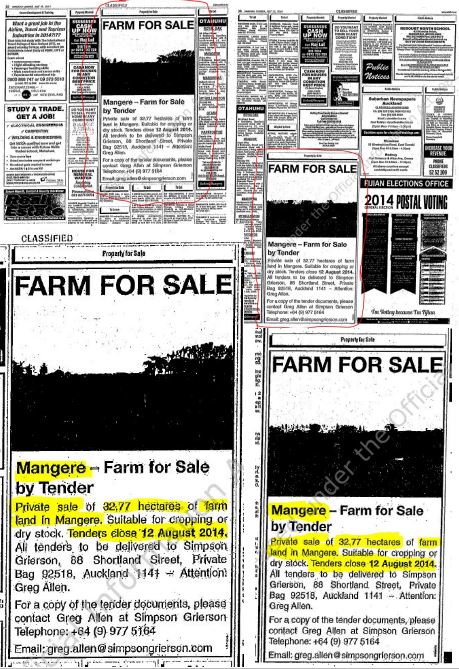
Whereas, in 1866 – following Freemason Governor Bro. George Grey’s eviction proclamation of July 9th 1863,lxx and a confiscation Order in Council of May 16th 1865, as well as Native Compensation Court proceedings of March to May 1866 that callously decided the lands at Ihumātao were forfeited because of “defection” to the so-called rebellion by “certain relatives and clansmen” of two great families – there were several Gazette Notices to auction the lands that stated the lot numbers, as The Snoopman showed in “Deep History of Ihumātao: The Methodist Connection”.lxxi The parcels of fertile land at Ihumātao, designated as Lot 13 (175) and 14 (176), were swiftly bought by Gavin Struthers Wallace at an auction held by the Waste Lands Office on July 17th 1866. This sale – which was sealed as a Crown Grant on 28th December of 1867 – bears the signature of no less a figure that the Governor of the Colony and Commander-in-Chief of the Armed Forces, Freemason Bro. George Grey. Ironically, Bro. Grey signed this land grant a month after he himself received notice of his recall as Governor of the colony to return to London.
In 1867, the Bank of New Zealand’s London agent successfully sold £464,200 in New Zealand government debentures to the merchant bank, N. M. Rothschild, an event that signalled the colony had achieved credibility. This sale was part of a £500,000 debenture offer and was the remainder of the £3 million loan which had been authorized by the New Zealand Loan Act of 1863 to finance the escalation of the New Zealand Masonic Revolutionary War.
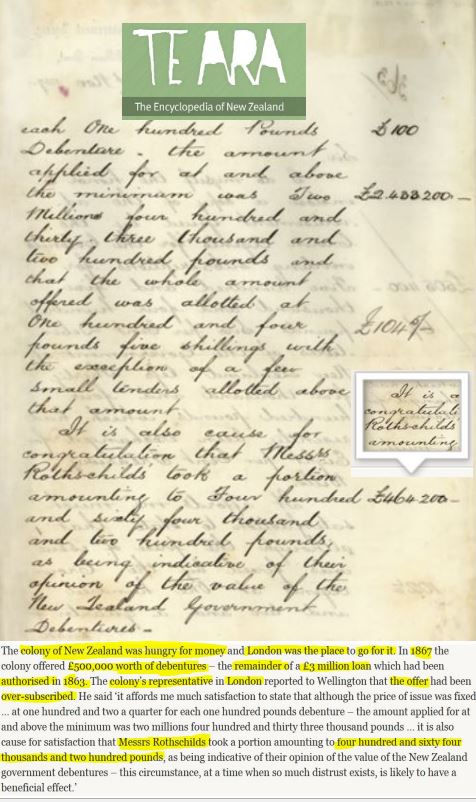
In 1875, N. M. Rothschild loaned the New Zealand Government £4 million at 4.5% interest for Immigration and Public Works, as “A Century of Finance” recorded the London House of Rothschild’s financial vampirism – as compiled by Jules Ayer .
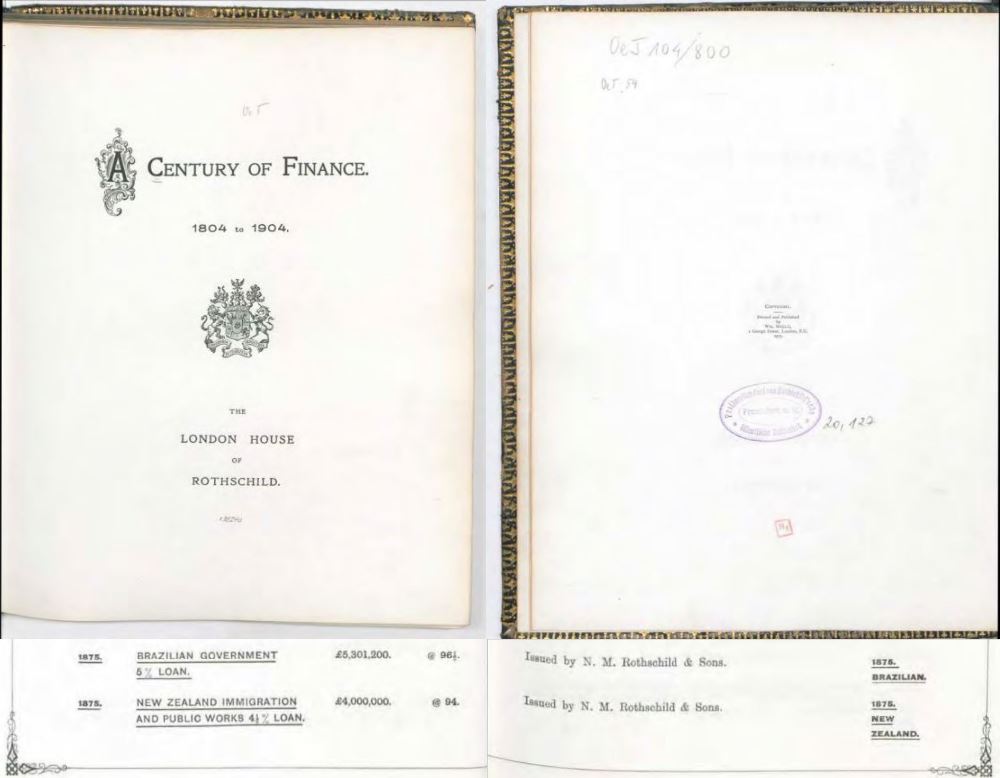
Given Freemason Governor Bro. Grey’s callous part in evicting tangata whenua of Ihumātao at the start of the Waikato War of 1863-64 that he spent 21 months strategizing – to finish off the job that his Freemason Brethren had plotted from near and far when they picked Waitara to trigger the First Taranaki War I of 1860-61 – and Bro. Grey’s creation of a seemingly unchallengeable private title for ‘the Wallace Block’ in late December 1867, it is exquisitely poetical that the current Governor General is Dame Patsy Reddy.
🎯
The Fletcher Connection »»
The current Governor-General and Commander of the New Zealand Armed Forces, is a protégé of the founder of Brierley Investments Limited (BIL), Ron Brierley, who was arrested for possession of child sex abuse images on electronic storage devices by New South Wales Police at Sydney Airport on Tuesday 17th December 2019, while attempting to board a flight for Fiji. (The biographer of the 1990 book, Brierley, the Man Behind the Corporate Legend, Yvonne van Dongen, said she wasn’t surprised about the arrest, because she wrote that he frequently travelled to Asia – mostly to Thailand – where he enjoyed encounters with young women – often teenage prostitutes. You’ve got to wonder do the N.Z. Police ever pause from throwing the book at ordinary people to actually read one that might lead to busting the super-wealthy?) During her 11-year stint at Brierley Investments from 1987 to 1998, Reddy oversaw Brierley’s Sky City Casino Complex project in Auckland, while Fletcher Construction was building it between 1993 and 1996. Reddy, whose wealth is reported to be $20 million, was a director on the board of SkyCity Entertainment Group Ltd from 1996 until 2008 – the year that Wall Street crashed the global casino-ized economy.
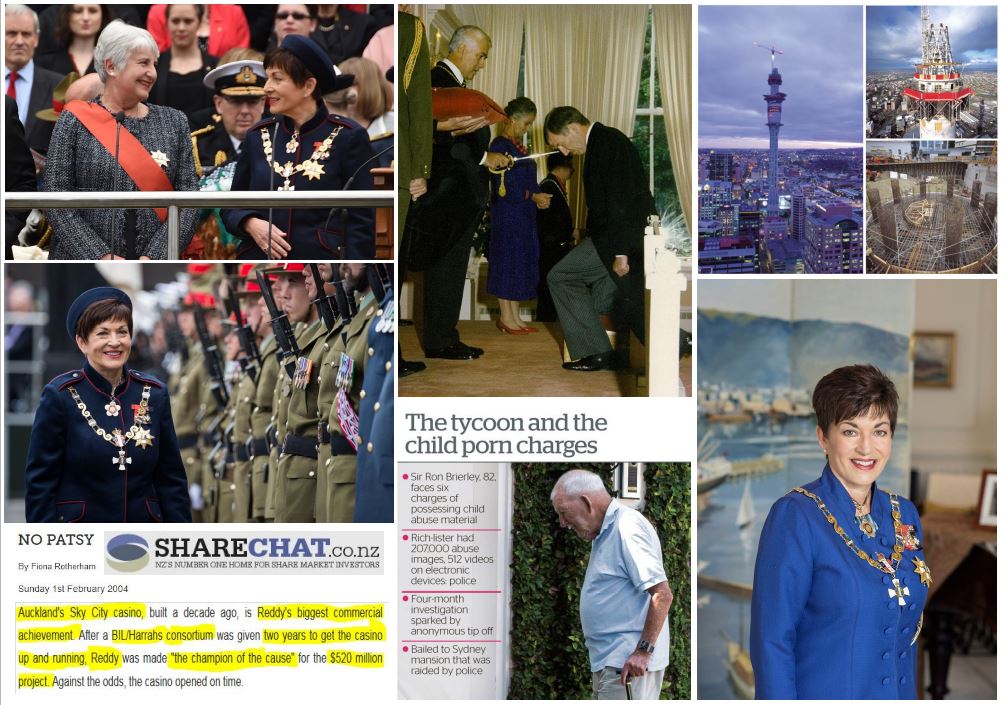
The corporate raider – whose empire had stakes in 300 companies and surpassed Fletcher Challenge as the largest N.Z. company at its peak, with a market value of $7.7 billion in 1986 – was also chairman of the Bank of New Zealand from September 1987 to February 1989, during which time the Bank was bailed-out by the Labour Government for $600 million in 1989. Brierley resigned from the BNZ board before the stated-owned bank was bailed out again in 1990 by the incoming Bolger-National Government, whom forked out $620 million while merchant bank Fay Richwhite stumped up $100 million for a 30% stake. The BNZ faced failure because the bank was exposed to collapsed commercial property booms in Auckland and Sydney following the October 1987 Sharemarket Crash.[21]
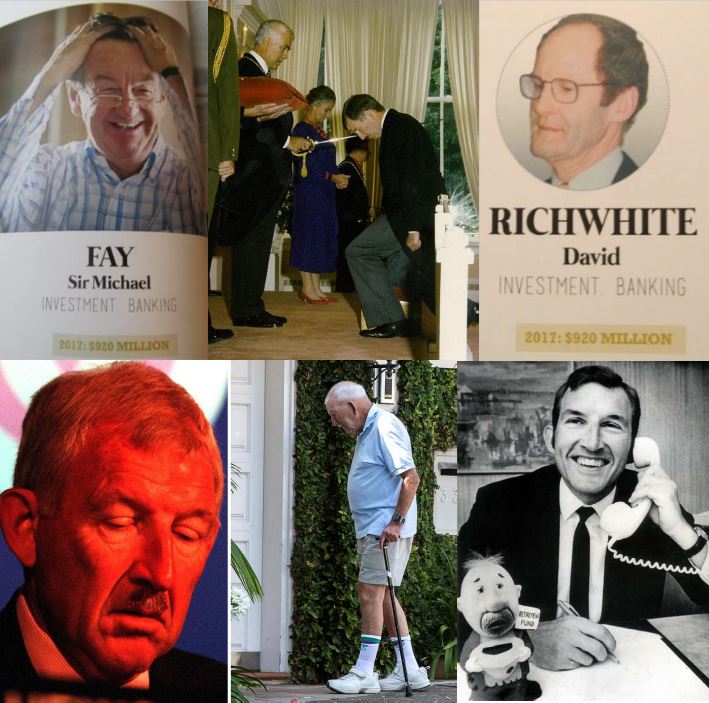
In 1992, the Bank of New Zealand was sold to National Australia Bank for $1.4 billion, or 80 cents a share, compared with the BNZ’s estimated value of about $7 billion. Simultaneously, the Secretary of the N.Z. Treasury, Graham Scott, sounded a warning to the Bolger Government of a fiscal deficit that he claimed could blowout to $5.2 billion. Scott, who was a member of the Neo-Feudal think-tank, the Centre for Independent Studies, that was founded by state-asset raider Allan Gibbs, failed to mention that on one winter’s night in 1894, the Colonial Government hastily passed the Bank of New Zealand Share Guarantee Act 1894, with the state guaranteeing an issue of £2 million in share capital,lxxii and from then until 1992, the BNZ was owned by the Crown. The Colonial version of Bank of New Zealand had recklessly loaned to property speculators whom comprised the Colonial Oligarchy, particularly those in the orbit of the bank’s primary founder, Thomas Russell.
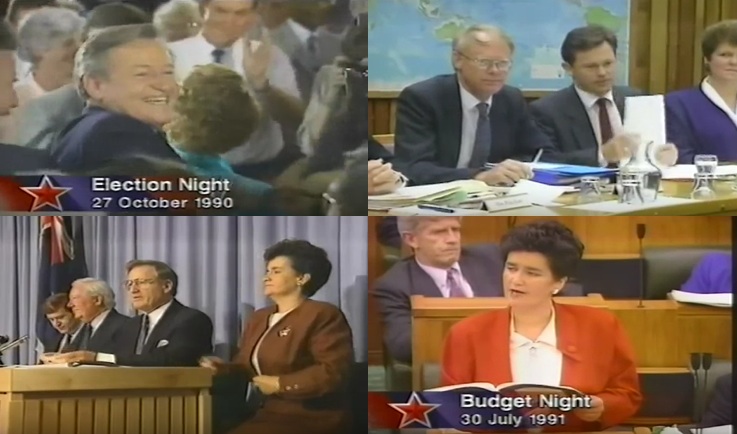
It turns out that a $3.4 billion financial asset management firm, FNZ, which boasts $670 billion under management and has a 2% ownership stake in the Fletcher Building consortium – actually manages the assets of Bank of New Zealand (among many other corporations). The Bank of New Zealand’s involvement in the coordinated take-down of the New Zealand dollar as part of the siege on the incoming Lange Labour Government in July 1984, makes the Bank of New Zealand’s links to the ownership of Fletcher Building and to the Deep History of Ihumātao – hugely significant. Especially, when it is remembered that the Bank of New Zealand brokered finance of £3 million from the London and Sydney money markets (after the Imperial Government turned its agents down), to escalate the New Zealand Masonic Revolutionary War of 1860-1872,lxxiii and also supplied an overdraft that peaked as high as £818,000 to the Colonial Government to wage the Waikato War of 1863-64lxxiv – as The Snoopman recounted in “Deep History of Ihumātao: The BNZ Connection”.lxxv

Fascinatingly, FNZ grew out of First NZ Capital, which morphed out of Credit Suisse First Boston (CS First Boston), which transmogrified out of Jarden Custodial Services that established itself in New Zealand in 1969 as an offshoot of the 1950s Jarden Corp.lxxvi It’s US-based corporate alter-ego, CS First Boston was itself a merger in 1988 between Swiss bank Credit Suisse and the First Bank of Boston. For its part in the Neo-Feudal corporate takeover of New Zealand, First NZ Capital produced many ‘free market’ reports, advice and consultants on the planned privatizations of N.Z.’s state assets, as journalists Paul Harris and Linda Twiname found in First Knights: An Investigation of the New Zealand Business Roundtable. (Ron Trotter’s son Bill was managing director and then-chairman of First NZ Capital). FNZ’s parent company – Falcon Newco – is registered in the Cayman Island’s tax haven.
🎯
The Fletcher Connection »»
Of the four Treasury officials lured by First NZ Capital into its employ – Bryce Wilkinson, Rob Cameron, Susan Begg and Stephen Jennings – one has the particular distinction that he was mentored by both of ‘the two Ronnies’ during the Halcyon Days of the Neo-Feudal Siege of New Zealand: Ron Trotter and Ron Brierley.

That ex-Treasury official is is Neo-Feudal billionaire Stephen Jennings – who started out in Treasury in 1984 at the beginning of the Lange-Labour Ministry and then moved to Credit Suisse First Boston’s Wellington office. Jennings advised the New Zealand and Australian governments on privatization, state enterprise restructuring and a variety of private sector mergers and acquisitions and capital markets transactions before being sent from London to Moscow in 1992 by Credit Suisse First Boston to set up an investment bank with a colleague, Boris Jordan, who was a grandson of Soviet émigrés and a fluent Russian speakerlxxvii – as The Snoopman reported in “A Billionaire’s Pep-talk to the ‘Switzerland of the South Pacific’ – New Zealand”.lxxviii
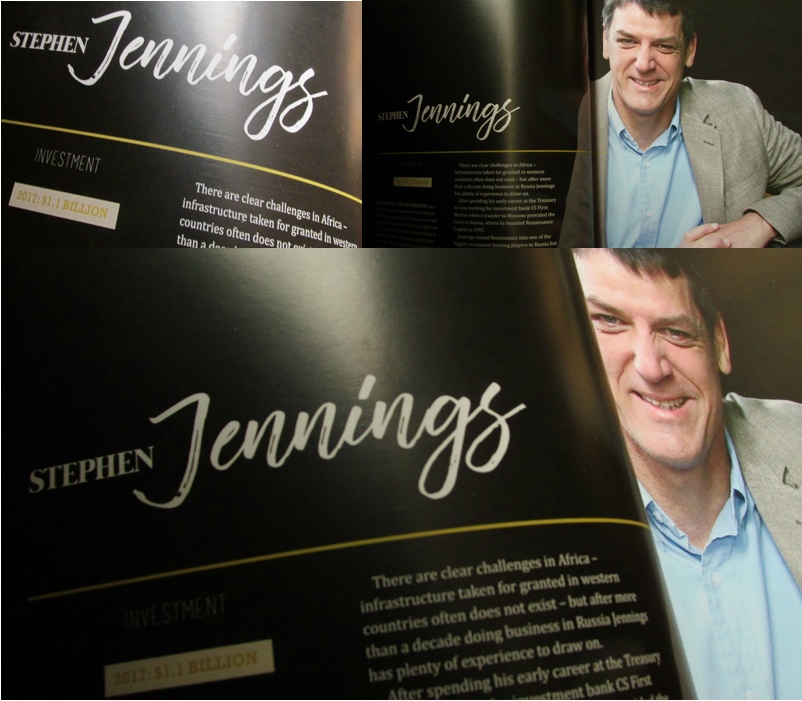
Jennings, who once described himself as an ‘economic missionary’, and who periodically returns to New Zealand to bestow his wisdom, proposed cutting Council restrictions on house building in Auckland, and urged the Auckland Council to open up more land for intensified housing, when he was last reported to be here in July 2016. These economic missionary prescriptions were delivered to the revamped Business Rountable think-tank, rebranded as The New Zealand Initiative, 12 days prior to the Auckland Super Council’s unveiling of its ‘Unitary Plan’ for more intensive residential development. Ironically, the Waitara-born billionaire’s talks and TV interview on TVNZ’s Q + A also extended to teachers, when he said no other sector had resisted reform like education. Jennings neglected to mention the super-rich Neo-Feudal Oligarchy Sector, perhaps because he has not read Oligarchy, in which Professor Jeffrey Winters explains that oligarchs can only exist in societies of extreme economic inequality.lxxix Furthermore, as Webster Griffin Tarpley had pointed out in his “Against Oligarchy” series, oligarchs thrive in crisis-ridden societies, and are the root cause of a crisis-ridden world because their philosophy of Oligarchism is the perceived right to rule the world, which leads to their psychopathic diabolical plots being inflicted without responsibility, empathy or wisdom.lxxx
🎯
The Fletcher Connection »»
The asset management company, FNZ Custodians, which like HSBC, JP Morgan and CitiBank, owned stocks in a company called Rubicon, which was set up in 2001 by Hugh Fletcher to facilitate the takeover Fletcher Challenge Energy (which grew out of the state-owned PetroCorp) by Royal Dutch Shell and Apache Corporation – as business analyst Brian Gaynor wrote in “Selling all our assets makes New Zealanders ‘serfs in our own country’”. As The Snoopman reported on September 6th 2019, in “Te Warena Taua – The mandated kaumātua who authored his own use-by-date?”, Hugh Fletcher of the Fletcher Dynasty was a director of Rubicon, whose major shareholdings were like a mirror image of Fletcher Building. That is, until September 30th 2019 when Rubicon changed its name to Arborgen Holdings, amid the under-the-radar attention that Hugh Fletcher and his wife, Sian Elias, the Chief Justice of the Supreme Court, were getting on social media while the Ihumātao was highly topical news and current affairs material. Although Hugh Fletcher is no longer a director, and the company has undergone a rebrand, its shareholders rename the same, including Fletcher Brothers 1.13% stake of 5.6 million shares.lxxxi

🎯
The Fletcher Connection »»
Given the spidery web-like linkages between Fletcher Building’s corporate ancestor, Fletcher Challenge, and their current networked interlocks to company brands that on closer inspection look like tentacles, and to think-tanks that move like religious cults, and to banks that smell like stinky-stenchy sewers – it is fitting to meet one more entity in the slew of the Fletcher Building corporation: Firth Industries.
Firth, which was bought by Fletcher Holdings in 1979, connects back to the confiscation of the disputed land on the Ihumātao Peninsula through the father of firm’s founder. Firth Industries was formed out of Firth Concrete Co., which was previously known as Ironclad Products, that started as a plant established in 1925 by Ned Firth at Rangariri on the Waikato River to manufacture domestic laundry boilers made from pumice concrete. Ned’s father was Josiah Clifton Firth, who as a political lawmaker in the Colonial Government, seconded Thomas Russell’s motion to introduce the New Zealand Bank Bill on June 19th 1861,lxxxii to establish the Bank of New Zealand (on whose board he would become a director from 1877 to 1884).lxxxiii
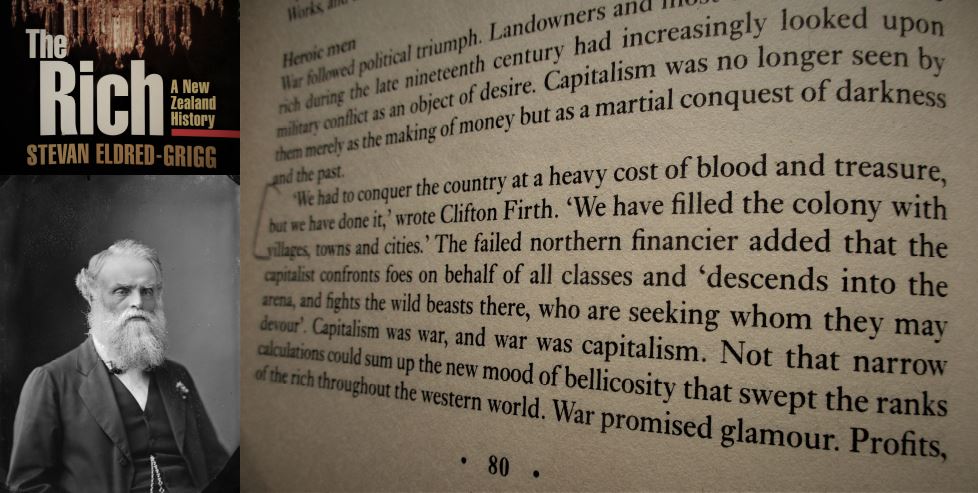
After the New Zealand Masonic Revolutionary War, Josiah Clifton Firth justified the colonists’ conspiratorial chess, saying:
“We had to conquer the country at a heavy cost of blood and treasure, but we’ve done it. We have filled the colony with villages, towns and cities.”lxxxiv
Firth was a director of Bank of New Zealand from 1877 to 1884.
🎯
The Fletcher Connection »»
Firth Industries now operates a concrete plant in the Auckland Airport ‘precinct’ to maintain the runways on the Ihumātao Peninsula.lxxxv Scoria for building the runways of Auckland Airport were quarried in the 1950s and 1960s from the main volcanic cones of Ōtuataua, located inside the Ōtuataua Stonefields Historic Reserve, and the now-devoured Maungataketake, to the south on the Ihumātao Peninsula. The mining of these ancestral maunga scoured deep into the history of Ihumātao. Particularly when you learn that at the very place of the occupation, Puketapapa, one of Newton’s tupuna or ancestors, lived – as she told Vice Magazine in mid-2017, in a story “Taking the Fight for Ihumātao All the Way to the United Nations”. This tupuna is no less a figure than Te Aho o te Rangi Wharepu, son of Pōtatau Te Wherowhero — the first Māori King, who was elected to the position at a ‘monster Maori gathering’ Ihumātao in mid-1857. Chief Te Wherowhero, who was the only chief at the time with the necessary mana to establish a Kingship — reluctantly agreed — and was elected with a clear mandate: place a tapu, or sacredly tabu decree, over Māori lands to halt further sales to the Colonial Crown, Pākehā settlers and colonization companies.
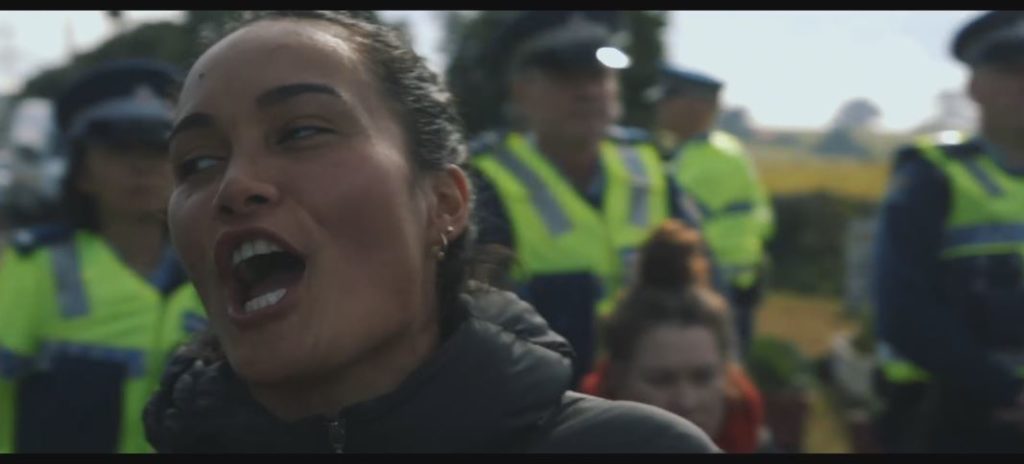
‘the six cousins’ is Te Warena Taua’s niece, Pania Newton, who bought a caravan in 2016 to occupy the Ihumātao land.
In fact, two of five meetings that established the Kiingitanga occurred at Ihumātao between 1856 and 1858, which you would think would reinforce the mana of Ngāti Te Ahiwaru and Ngāti Māhuta. Ihumātao is also the second landing place of the Tainui waka after it crossed the portage at Ōtāhuhu in 1300AD. With this ancestral heritage — you can now ask the loaded question: what were Fletchers, the Council, the Courts and the Crown thinking – or reading or consulting?
What the Fletcher-Rockefeller-Rothschild Dynasties Rabbit-Hole means
To sum up, New Zealand’s Pākehā-dominated Ruling Élite – including those linked to the Fletcher Building cartel – have been unwilling to acknowledge that the ‘growth locomotive’ that they have actively constructed was designed to create a crisis-ridden Neo-Feudal ‘market economy’ in which a super-rich oligarchy could materialize and thrive. In the process, New Zealand economy, its companies and its strategic resources became more tightly teethered to the ‘Trilateral World’ of North America, Western Europe and Japan.
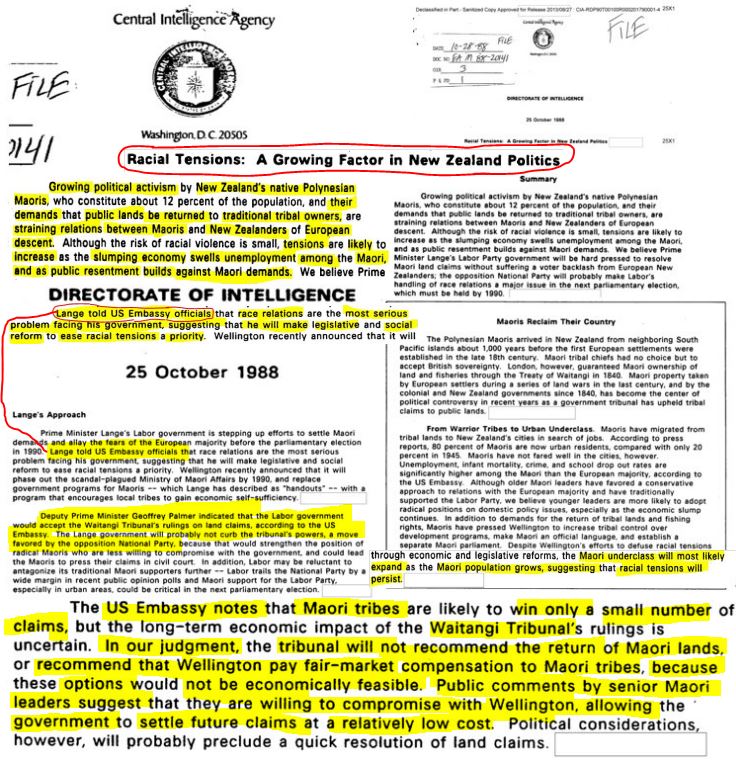
The vision of a ‘Switzerland of the South Pacific’ was about forging an unequal society that required smashing the value of egalitarianism, countering the renaissance of indigenous Māori – who were down to 3.74 million acres out of New Zealand’s 66.4 million acres in 1996 – and about forging a super-rich plutocracy. The Rich Lister plutocratic oligarchy and their National Security State counterparts would rule government by stealth as a cohesive Deep State that had captured the Public State.
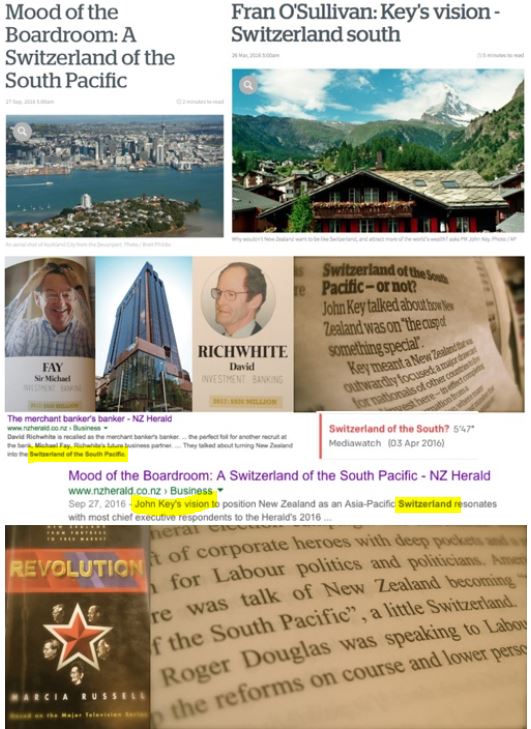
Fletcher Challenge and other corporate members of the New Zealand Business Round Table – such as First NZ Capital (CS First Boston), merchant bankers Fay Richwhite, corporate raiders Brierley Investments, the Bank of New Zealand, along with the ANZ, the National Bank, Westpac, and ASB – are complicit in the stealthy moves to make Greater Auckland into a huge agglomeration to suit the interests of transnational corporations. The un-mandated moves to make Greater Auckland into a huge city was an expression of a broader ‘World Cities Movement’ Project that has forged Global Cities. This secret scheme is how Auckland eventually came to have a housing crisis, and explains how Ihumātao came to be selected as one of numerous locations across the city as a place of intensified housing designated Special Housing Areas. The rail-roaded city-wide rezoning for intensive housing was another application of blitzkrieg Shock Doctrine economic warfare strategy to push ahead Auckland as Global City for the beneficial exploitation of transnational corporations.
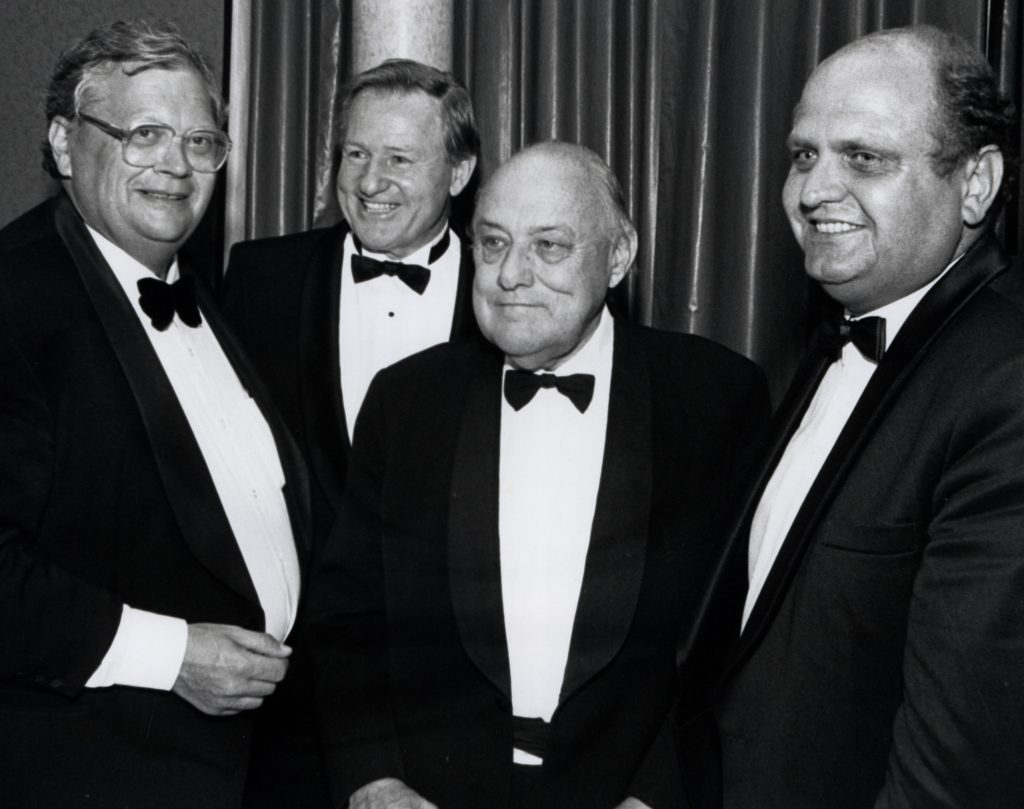
Successive New Zealand Government’s since the Lange-Labour Government have been recklessly complicit in protecting the racketeering interests of cartelized commerce, including the three transnational banks, JP Morgan Chase, HSBC and CitiBank and the asset management firm FNZ, as well as the Bank of New Zealand and Fletcher Building Limited. The Ardern Coalition Government and the Executive Council maintains a reckless contrived ignorance about the structural racketeering and regulatory capture inflicted upon New Zealand by Fletcher Challenge and Accomplices, including the memberships of the New Zealand Business Round Table, the Council on Foreign Relationships, the Trilateral Commission and the Bilderberg Group.
Given that the root cause of New Zealand’s crisis-ridden state is the existence of Transnational and Domestic Neo-Feudal Oligarchies, whom have viciously inflicted their diabolical philosophy of Oligarchism to transform the society into a hi-tech Smart-Grid Technocratic Neo-Feudal Tax Slave Plantation – defections from the Neo-Feudal Game can be expected, at least in theory. In practice, whistle-blowing mutinies within and across institutions requires political balls or ovaries, or both, as the case may be. It also requires love and other acts of anarchy (in the positive sense of the word, since true acts of love cannot be regulated, and as a universal force can be harnessed to forge self-determining autonomous communities beyond the regulation of constituted authorities). The Protect Ihumātao SOUL campaign is an exemplary example of a fight grounded in this universal force of aroha to combat the localized incursion of darkness of a broader New World Order sub-project: the Switzerland of the South Pacific Utopian dystopia.
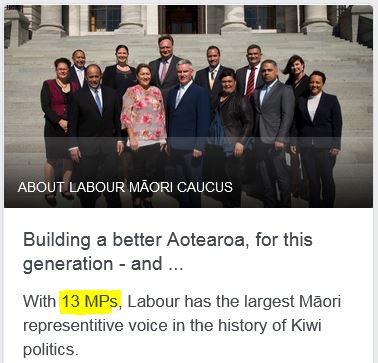
defect from this 35-year-old economic warfare game of Neo-Feudal Oligarchy, and upend the block on private land buybacks?
The regulatory capture of the New Zealand Government by a Neo-Feudal Confederacy that occurred in 1984 persists today, despite a 13-‘strong’ Māori Labour Caucus working alongside the Ardern Coalition Government. This systemic regulatory capture leads to a provocative question: Will the Māori Labour Caucus defect from this 35-year-old economic warfare game of Neo-Feudal Oligarchy, or will they become known in the new history books as the ‘Thirteen Ngāti Illuminati’?
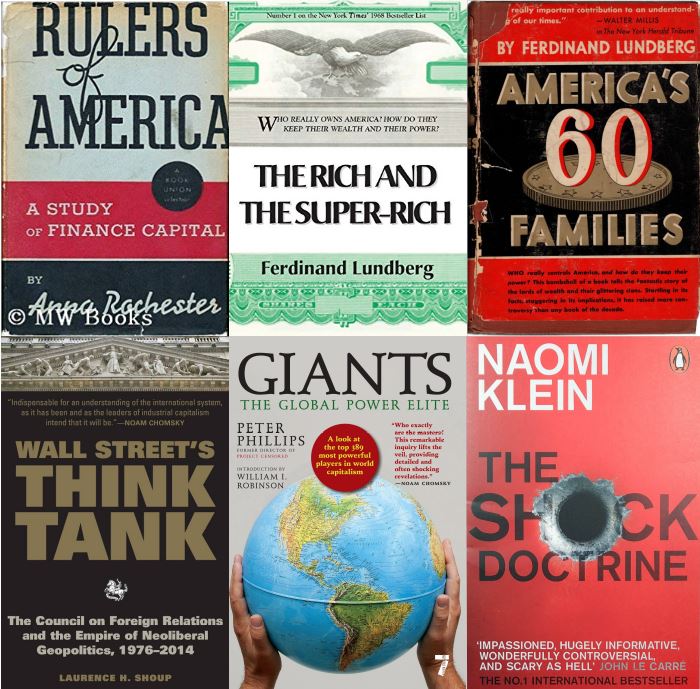
Given Anna Rochester’s groundbreaking 1936 study of monopoly capitalism, America’s Rulers, that focussed on the Rockefeller and Morgan orbits, and given Ferdinand Lundberg’s excellent works, America’s 60 Families and The Rich and Super-Rich, as well as Laurence Shoup’s Wall Street’s Think Tank, Noami Klein’s The Shock Doctrine and Professor Peter Philips’s 2018 book, Giants: The Global Power Elite — The Snoopman would not be surprised to find that New Zealand has ‘Twenty Ruling Neo-Feudal Families’.

Referenced Sources:
i Selwyn Parker. (1994). Made in New Zealand: The Story of Jim Fletcher. Hodder & Stoughton; Fletcher Building Limited Annual Report 2018. Retrieved from https://fletcherbuilding.com/assets/4-investor-centre/annual-reports/2018-annual-report.pdf
ii Another entity in the slew of the Fletcher Building corporation is Firth Industries, which was bought by Fletcher Holdings in 1979, connects back to confiscation of the disputed land on the Ihumātao Peninsula through the father of firm’s founder. Firth Industries was formed out of Firth Concrete Co., which was previously known as Ironclad Products, that started as a plant established in 1925 by Ned Firth at Rangariri on the Waikato River to manufacture domestic laundry boilers made from pumice concrete. Ned’s father was Josiah Clifton Firth, who as a political lawmaker in the Colonial Government, seconded the motion to introduce the New Zealand Bank Bill on June 19th 1861,xli to establish the Bank of New Zealand (on whose board he would become a director from 1877 to 1884).xlii The Bank of New Zealand brokered finance of £3 million from the Imperial Government to escalate the New Zealand Masonic Revolutionary War of 1860-1872,xliii and supplied an overdraft that peaked as high as £818,000 to the Colonial Government to wage the Waikato War of 1863-64 – as The Snoopman recounted in “Deep History of Ihumātao: The BNZ Connection”.xliv Lands on the Ihumātao Peninsula were confiscated off Māori in 1865-66 during the ‘Great War for New Zealand’, following the serving of Freemason Governor Bro. George Edward Grey’s eviction notice served, just three days before the outbreak of the Waikato War. Firth was a director of Bank of New Zealand from 1877 to 1884. Firth Industries now operates a concrete plant in the Auckland Airport ‘precinct’ to maintain the runways on the Ihumātao Peninsula.xlvi Scoria for building the runways of Auckland Airport were quarried in the 1950s and 1960s from the main volcanic cones of Ōtuataua, located inside the Ōtuataua Stonefields Historic Reserve, and the now-devoured Maungataketake, to the south on the Ihumātao Peninsula. The mining of these ancestral maunga scoured deep into the history of Ihumātao.
iii The Fletcher Trust Archive. http://fletcherarchives.co.nz/companies-represented.php
iv Marcia Russell. (1996). Revolution: New Zealand from Fortress to Free Market. Mairangi Bay; New Zealand: Hodder Moa Beckett; Kelsey, Jane. (1995). The New Zealand Experiment: A World Model for Structural Adjustment? Pluto Press; Marcia Russell. (1996). Revolution [Motion Picture]. https://www.nzonscreen.com/title/revolution-1996/series; Barry, Alister. (1995). Someone Else’s Country. [Motion Picture]. Vanguard Films. Retrieved from http://www.nzonscreen.com/title/someone-elses-country-1996; Barry, Alister. (2002). In a Land of Plenty. [Motion Picture]. Vanguard Films. Retrieved from http://www.nzonscreen.com/title/in-a-land-of-plenty-2002 [In 5-part video segments].
v Critical works of New Zealand’s ‘free market reforms’ that have called attention to the deliberate disenfranchisement of the mass populace and the lack of a popular mandate to deploy them, include: Jane Kelsey’s The New Zealand Experiment (1995); The FIRE Economy (2015); Bruce Jesson’s, Behind the Mirror Glass: The Growth of Wealth and Power in New Zealand in the Eighties (1987); Only Their Purpose is Mad: The Money Men Take Over NZ (1999); Marcia Russell’s, Revolution: New Zealand from Fortress to Free Market (1996); filmmaker Alister Barry’s documentaries, Someone Else’s Country: The Story of the New Right Revolution in New Zealand and In a Land of Plenty: The Story of Unemployment in New Zealand, as well as the four part series, Revolution, produced by Marcia Russell in 1996 at: https://www.nzonscreen.com/title/revolution-1996/series
vi By December 1994, 13 state-owned enterprises were sold for a mere $13 billion: New Zealand Steel, Petrocorp, Development Finance Corporation, Rural Bank, the National Film Unit, the Government Post Office, Telecom, Housing Corporation, Forest Corporation, the Bank of New Zealand, New Zealand Rail, Export Guarantee Corporation, and Government Computing Services. See: Jane Kelsey. (1998). The New Zealand Experiment, p. 135; Robert Barwick et al. (January-March, 1997). Her Majesty’s Mont Perelin Society assaults New Zealand, p. 6-11. In: Nazi ‘reforms’ rip apart New Zealand – Australia Next. The New Citizen Report. Vol.4, No. 7. Citizens Electoral Council, Australia.
vii Fletcher Challenge bought: Petrocorp for $801 million, a $254 million stake in Maui Gas; NZ Liquid Fuels for $203 million, Synfuels for $121 million, a $119 million stake in Taranaki Petroleum mining licenses, paid $687 million for Rural bank, $262 million in Forest cutting rights. The Forestry Corporation of New Zealand, or ForestCorp, was sold in 1996 for $1.6 billion to Fletcher Challenge (37.5%), Brierley Investments (25%), and Citifor Inc (37.5%).
viii CARROLL DU CHATEAU and WARREN GAMBLE (21 march 2001). Fletcher: End of an empire. https://www.nzherald.co.nz/business/news/article.cfm?c_id=3&objectid=177631
ix Private conversation with a witness present at this December 1986 dinner.
x Marcia Russell. (1996). Revolution: New Zealand from Fortress to Free Market, p. 141; Michael Reddell. (29/03/2016). Switzerland of the South Pacific: cargo cult thinking? Croaking Cassandra
xi Stevan Eldred-Grigg. (1996). The Rich: A New Zealand History, p. 206. Penguin Books.
xii Ian Wishart. (1995). The Paradise Conspiracy. Howling at the Moon Publishing.
xiii William Tell and The Templar Nation | Atlantis Rising Magazine Library. https://atlantisrisingmagazine.com/article/william-tell-and-the-templar-nation/
xiv The corporate raiders, who made their fortune on the privatizations such as the Bank of New Zealand, Tranz Rail and Telecom, have bolt-holes on the Great Mercury Island, an island they acquired in 1978 in circumstances that have never been properly explained. See: NZ Herald. (15 Oct, 2004 ). The merchant banker’s banker http://www.nzherald.co.nz/business/news/article.cfm?c_id=3&objectid=3601127
xv Selwyn Parker. (1994). Made in New Zealand, p. 207-209.
xvi Robert Muldoon and the New Zealand economic crisis, 1975-84, p. 10-15. https://apebhconference.files.wordpress.com/2009/08/mcaloon1.pdf
xvii Revolution: Part One – Fortress New Zealand. https://www.nzonscreen.com/title/revolution-1-fortress-new-zealand-2009
xviii John Roughan (3 August 2005). July 1984: When life in NZ turned upside down. Retrieved from http://www.nzherald.co.nz/john-roughan/news/article.cfm?a_id=5&objectid=3576219
xix Otago University. Alumini & Friends. Q&A with Hugh Templeton. https://www.otago.ac.nz/alumni/people/hugh-templeton.html; Stevan Eldred-Grigg. (1996). The Rich: A New Zealand History, p. 188. Penguin Books.
xx Selwyn Parker. (1994). Made in New Zealand, p. 211-217.
xxi For the technocracy aspects of the New World Order Utopian vision, see: Patrick Wood. (2015). Technocracy Rising: The Trojan Horse of Global Transformation. USA: Coherent Publishing. Patrick Wood. (23 June 2011). “Technocracy Endgame: Global Smart Grid.; Patrick Wood. (2 March 2010). “Smart Grid The Implementation of Technocracy? “; Retrieved from: http://www.bibliotecapleyades.net/ciencia/ciencia_energy52.htm#Smart%20Grid:%20The%20Implementation; Katherine Albrecht and Liz McIntyre (2006). Spychips: How Major Corporations and Government Plan to Track Your Every Purchase and Watch Your Every Move. USA: Penguin.Retrieved from: http://www.spychips.com; Josh del Sol (2014). Take Back Your Power. Retrieved from: https://takebackyourpower.net/
xxii Bruce Jesson. (1999). Only Their Purpose is Mad, p. 112-113; Paul Goldsmith. (2012). Serious Fun: The Life and Times of Alan Gibbs. Random House.
xxiii Engdahl, W. (2004). A Century of War: Anglo-American Oil Politics and the New World Order (Rev. ed.), 127-141. London, England: Pluto Press; Engdahl, F. W. (2009). Gods of Money: Wall Street and the Death of the American Century, p. 265-272. Wiesbaden, Germany: edition.engdahl; Estulin, D. (2009). The True Story of the Bilderberg Group (North American Union ed.), p. 183-184. Walterville, OR: Trine Day LLC.
xxiv Notable New Zealanders: The Pictorial Who’s Who, p. 332. First Edition. Auckland: Paul Hamlyn Limited; Eric Pace (5 August 1992). Sir Robert Muldoon Is Dead at 70; Ex-New Zealand Prime Minister http://www.nytimes.com/1992/08/05/world/sir-robert-muldoon-is-dead-at-70-ex-new-zealand-prime-minister.html; Simon Walker. (6 August 1992). Obituary: Sir Robert Muldoon http://www.independent.co.uk/news/people/obituary-sir-robert-muldoon-1538341.html
xxv Revolution: Part One – Fortress New Zealand https://www.youtube.com/watch?v=JZXpeUQ0tD8; Barry, Alister. (1995). Someone Else’s Country. [Motion Picture]. Vanguard Films. Retrieved from http://www.nzonscreen.com/title/someone-elses-country-1996; Barry, Alister. (2002). In a Land of Plenty. [Motion Picture]. Vanguard Films. Retrieved from http://www.nzonscreen.com/title/in-a-land-of-plenty-2002 [In 5-part video segments]
xxvi David Levy. (June 1, 1999). Interview with Donald Brash An interview with the head of New Zealand’s central bank. https://www.minneapolisfed.org/article/1999/interview-with-donald-brash
xxvii Naomi. Klein. (2007). The Shock Doctrine: The Rise of Disaster Capitalism. Camberwell, Australia: Penguin; Whitecross, M & Winterbottom, A. (Directors) & Eaton, A. (Producer). The Shock Doctrine 2009 [Motion picture] Retrieved from https://www.youtube.com/watch?time_continue=20&v=v6yceBTf_Vs&feature=emb_logo
xxviii Kelsey, Jane. (1995). The New Zealand Experiment.
xxix ‘Structural adjustments’ were a euphemism for ‘shock treatment’ policies, wherein countries were pressured to implement the ‘free-market’ economic model, such as privatization of state-owned infrastructure, in exchange for emergency IMF loans and World Bank debt rescheduling. Inevitably, the structural adjustments ‘failed’ to generate enough tax revenue to service the loans and ‘austerity programmes’ were proscribed. These measures involved cuts to social programmes such as education, health and public housing, which were viewed as a misallocation of resources because they did not service debt and generate exports.
xxx Jane Kelsey. (2015). The FIRE Economy, p. 49.
xxxi Marcia Russell. (1996). Revolution: New Zealand from Fortress to Free Market. p. 57.
xxxii Reserve Bank officials such as Dr Roderick Deane knew who had traded against the currency on knowledge that its value would drop once the Lange government was formed. When Deane claimed Marcia Russell’s documentary series, Revolution, that his major worry was the public did not know what was going on, he was deploying an Inoculation Ritual, which is a public relations tactic to downplay the inherent weakness of a position taken and then quickly move on – thereby inoculating the audience with a Neo-Feudal shot of ‘brainwashing vaccine’. The former Reserve Bank official, who sacked 2270 workers as CEO of Electricorp (1987-1994), justified his complicity saying he acted to protect the integrity of the Reserve Bank. In this way, Deane advanced the Neo-Feudal Siege of Wellington and New Zealand. (The currency was devalued 20% on July 18 1984 and climbed back later). But, there were no whistle blowers willing to defect. Such information would have yielded valuable information about the milieu of conspirators behind the 1984 political-economic coup.
xxxiii Marcia Russell. (1996). Revolution: New Zealand from Fortress to Free Market. p. 56
xxxiv Steven Stillman, Malathi Velamuri and Andrew Aitken. (July 2008). The Long-Run Impact of New Zealand’s Structural Reform on Local Communities, p. 5. Motu Working Paper 08-11. Motu Economic and Public Policy Research. http://motu-www.motu.org.nz/wpapers/08_11.pdf
xxxv It is rather ironic that Fletcher Building is 26% owned by HSBC, given the bank was founded as Hong Kong Shanghai Bank in 1865 to funnel drug money to elite Anglo-Swiss families to grease the wheels of empire following the Britain’s Opium Wars against China. The siege of China through the opium trade was escalated in 1828 when Jardine Matheson and Company formed to become the largest opium enterprise in the world, with its business entwined with the Hong Kong Shanghai Bank, according to the publishers of Dope Inc: Britain’s Opium War Against the World, Executive Intelligence Review. It is therefore particularly ironic that Fletcher Building is 26% owned by HSBC, because while the first siege against China in 1840 was being planned by Freemason Secretary of State of Foreign Affairs, Bro. Lord Palmerston (1835-1841), the British Crown also laid a hidden ‘Colonial Law Track’ in 1839-1840 parallel to a ‘Treaty Theatre Track’ to stealthily takeover New Zealand. Two decades later, as British Prime Minister (1859-1865), Lord Bro. Palmerston declared that British law should be respected in New Zealand, even if it should take 20,000 men to bring about that result – as the Bank of New Zealand’s Centenary book, Banker’s Hundred: A History of the Bank of New Zealand 1861-1961 boasted in 1961 about the ‘rebel Maoris’.
xxxvi FLETCHER BUILDING LIMITED (1104175). New Zealand Companies Office. Retrieved 13 December 2019 from https://app.companiesoffice.govt.nz/companies/app/ui/pages/companies/1104175/shareholdings?backurl=H4sIAAAAAAAAAC2LMQrDMBAEf6MmhV8gQlIkjYtA8oFDt9gC%2BaTcnQL%2BvYVJtzPMTo0W2JTq1kjyWAbStF63yojmJEzKwfeGCPHsIwnf%2BCjwtEIv954LZ1kC8Y8kgV8kKNG1I5z9%2FhlXi7d5%2FvPbybs9tfZ26gPUrDf5gQAAAA%3D%3D
xxxvii Michel Chossudovsky (2010). The Global Financial Crisis, p. 45; Johnson & Kwak. (2010). 13 Bankers, p. 85; Jillian Tett (2010). Fool’s Gold, p. 94
xxxviii Brown, E. H. (2008). The Web of Debt: The Shocking Truth About Our Money System and How We Can Break Free (2nd ed.). Baton Rouge, LA: Third Millennium Press; Eustace Mullins. (1991). The Secrets of the Federal Reserve: The London Connection, p.100. Carson City, Nevada, USA: Bridger House Publishers. Downloadable: 2018 Jekyll Island Edition Retrieved from: https://dokumen.tips/download/link/the-secrets-of-the-federal-reserve-the-london-connection-jekyll-island-edition
xxxix Francis Richard Conolly. (2014). JFK to 9/11: Everything Is a Rich Man’s Trick. [Motion Picture].
xl Eustace Mullins. (1991). The Secrets of the Federal Reserve: The London Connection. Carson City, Nevada, USA: Bridger House Publishers.
xli Reuters. Business News (May 30, 2012). Rothschilds buy into Rockefeller wealth business. https://uk.reuters.com/article/uk-rothschild-rockefeller/rothschilds-buy-into-rockefeller-wealth-business-idUKBRE84T01O20120530
xliiDan McCrum and Daniel Schäfer. (June 2 2012). Rockefellers’ family office comes of age https://www.ft.com/content/3d461a76-ab4e-11e1-a2ed-00144feabdc0; Harry Mount 30 May 2012. Rothschild and Rockefeller: their family fortunes – Telegraph. https://www.economicsvoodoo.com/wp-content/uploads/2012-05-30-Rothschild-Rockefeller-Their-Family-Fortunes_UKTelegraph.pdf
xliii CIA. (25 October 1988). “Racial Tensions: A Growing Factor in New Zealand, p. 3. Politics. Directorate of Intelligence. U.S. Central Intelligence Agency.
xliv Peter D. Hutchison and Kelly Nyks. (2015). Requiem for the American Dream: Noam Chomsky and the Principles of Concentration of Wealth & Power. Retrieved from https://www.youtube.com/watch?v=usTktxjTUd0
xlv Shoup, L. H. & Minter, W. (2004 [1977]). Imperial Brain Trust: The Council on Foreign Relations and United States Foreign Policy, 254-284. New York, NY: Authors Choice Press; Laurence H. Shoup. (2015). Wall Street’s Think Tank: The Council on Foreign Relation Relations and the Empire of Neo-liberal Geopolitics, 1976-2014. New York: Monthly Review Press;
xlvi Laurence H. Shoup. (2015). Wall Street’s Think Tank: The Council on Foreign Relation Relations and the Empire of Neo-liberal Geopolitics, 1976-2014. New York: Monthly Review Press; Shoup, L. H. & Minter, W. (2004 [1977]). Imperial Brain Trust: The Council on Foreign Relations and United States Foreign Policy, 254-284. New York, NY: Authors Choice Press; Estulin, D. (2009). The True Story of the Bilderberg Group (North American Union ed.). Walterville, OR: Trine Day LLC; Naomi. Klein. (2007). The Shock Doctrine; Pilger, J. (2002). The New Rulers of the World. London: Verso; Pilger, J. & Lowry, A. (2001). The New Rulers of the World, Carlton Television, Pinkus, Karen. “Nothing from Nothing: Alchemy and the Economic Crisis.” World Picture 2.
xlvii Engdahl, W. (2004). A Century of War: Anglo-American Oil Politics and the New World Order (Rev. ed.), p. 132, 134, 286-87; Engdahl, W. (2009). Gods of Money: Wall Street and the Death of the American Century, p. 266-267)
xlviii Public Intelligence. (June 12, 2016). Bilderberg Meetings1973 Conference Report Saltsjöbaden, Sweden. Bilderberg Archive. Retrieved from https://publicintelligence.net/bilderberg-conference-1973/
xlix Public Intelligence. (June 12, 2016). Bilderberg Foundation Report 1973, p.63.
l F. Kesicki. (2009). The third oil price surge – What is different this time and what are possible future oil price developments? Universität Stuttgart Institut für Energiewirtschaft und Rationelle Energieanwendung. Retrieved from https://www.ier.uni-stuttgart.de/publikationen/arbeitsberichte/downloads/Arbeitsbericht_07.pdf
li OPEC is a market-monopolizing cartel, Organization of Petroleum Exporting Countries.
lii Public Intelligence. 1973 Bilderberg Meeting Participant List. 1973 Bilderberg Meeting Participant List
liii Saskia Sassen (2005). The Global City: introducing a Concept. Brown Journal of World Affairs. https www.saskiasassen.com/pdfs/publications/the-global-city brown.pdf; Robinson, W. I. (2004). A theory of global capitalism: Production, class, and state in a transnational world. Baltimore, MD: John Hopkins University Press; de Angelis, M. (2001, May). Global capital, abstract labour, and the fractal panopticon. The Commoner. Retrieved from: http://www.commoner.org.uk/fractalpanopt.pdf
liv Knight Frank (2015). The Wealth Report, p28-31. Retrieved from: content.knightfrank.com/research/83/documents/en/wealth-report-2015-2716.pdf; World-Class Auckland: How to improve New Zealand’s largest city 14 Aug, 2015.
https://www.nzherald.co.nz/world-class-auckland-best-city-on-earth-herald/news/article.cfm?c_id=1503861&objectid=11496080; Is Auckland an entrepreneurial or global city? James E. Rowe The Town Planning Review Vol. 77, No. 5 (2006), pp. 583-604 Published by: Liverpool University Press https://www.jstor.org/stable/41229026
lv The Snoopman. (November 18, 2018). Secrets of Magical Credit Revealed: The Rigged System. https://snoopman.net.nz/2018/11/18/secrets-of-magical-credit-revealed/
lvi Mike Maloney. (2013). The Biggest Scam in the History of the World – Mike Maloney Ep 4. Retrieved from: https://www.youtube.com/watch?v=iFDe5kUUyT0; Ross Ashcroft. (2012). Four Horsemen; The Global Financial Crisis Renegade Films. Retrieved from: https://www.youtube.com/watch?v=5fbvquHSPJU
lvii Gillian Lawrence. (March 2008). The Reserve Bank, private sector banks and the creation of money and credit. Reserve Bank of New Zealand: Bulletin, Vol. 71, No. 1. https://www.interest.co.nz/opinion/77033/overview-functions-money-and-how-money-and-credit-are-created-nz-economy-examining
lviii Gillian Lawrence. (March 2008). The Reserve Bank, private sector banks and the creation of money and credit. Reserve Bank of New Zealand: Bulletin, Vol. 71, No. 1. https://www.rbnz.govt.nz/-/media/ReserveBank/Files/Publications/Bulletins/2008/2008mar71-1lawrence.pdf
lix Ott, M. (1982, May). Money, credit and velocity. Review, Federal Reserve Bank of St. Louis, p. 25.
lx Positive Money. (n.d.). How Banks Create Money. http://positivemoney.org/how-money-works/how-banks-create-money/
lxi Caley Callahan. (10/03/2017). New Zealand housing most unaffordable in the world – The Economist. http://www.newshub.co.nz/home/money/2017/03/new-zealand-housing-most-unaffordable-in-the-world-the-economist.html; The Economist (Mar 11th 2017).https://www.economist.com/blogs/graphicdetail/2017/03/daily-chart-6; THE DATA TEAM. (Mar 9th 2017). Global house prices. Retrieved from: https://www.economist.com/blogs/graphicdetail/2017/03/daily-chart-6
lxii Rosanna Price. (3 June 2016). One in 100 Kiwis homeless, new study shows numbers quickly rising. http://www.stuff.co.nz/national/80719962/One-in-100-Kiwis-homeless-new-study-shows-numbers-quickly-rising
lxiii National Business Review. (2017). NBR Rich List 2017.
lxiv The Snoopman. (September 6, 2019 ). Ihumātao Class Lesson #003: Te Warena Taua – The mandated kaumātua who authored his own use-by-date?https://snoopman.net.nz/2019/09/06/ihumatao-class-lesson-003-te-warena-taua/
lxv Simon Collins, Anne Gibson (Nov 6, 2015). 102 houses built out of target of 39,000. http://www.nzherald.co.nz/business/news/article.cfm?c_id=3&objectid=11540789; May 10, 2013 Auckland housing: 39,000 new homes in three years. Retrieved from: http://www.nzherald.co.nz/business/news/article.cfm?c_id=3&objectid=10882827; CHARLES ANDERSON (10 May 2013). New accord to boost Auckland housing.
lxvi David Norman. (17 August 2015). Outlook for Auckland residential construction. How many dwellings should we be building, and can we? p.2. Westpac Institutional Bank. Retrieved from: https://www.westpac.co.nz/assets/Business/Economic-Updates/2015/Bulletins-2015/Outlook-for-Auckland-residential-construction-August-2015.pdf; Brian Rudman. (31 July 2013). Foreigner ban won’t build one new home. Retrieved from: www.nzherald.co.nz/business/news/article.cfm?c_id=3&objectid=10905702; Harcourts. (27 May 2016). Vision needed to plan for housing needs. http://content.harcourts.co.nz/news/vision-needed-to-plan-for-housing-needs
lxvii New Zealand Herald. (11 August 2016). Vision for City Set for Green Light” Unitary Plan, p. 3.
lxviii The Snoopman. (September 24, 2019). Ihumātao | Fraught Precedents for Land Buy-Backs
Ihumātao | Fraught Precedents for Land Buy-Backs
lxix Snoopman. (25 April 2017). “The Masonic New Zealand Wars: Freemasonry as a Secret Mechanism of Imperial Conquest During the ‘Native Troubles’” Retrieved from https://snoopman.net.nz/2017/04/25/the-masonic-new-zealand-wars/https://snoopman.net.nz/2017/04/25/the-masonic-new-zealand-wars/
lxx Snoopman. (July 30, 2019). Deep History of Ihumātao: The Freemason Connection. https://snoopman.net.nz/2019/07/30/deep-history-of-ihumatao-the-freemason-connection/
lxxi For Bro. Grey’s Crown Grant of 28th December 1867 to Scottish Methodist farmer Gavin Struthers Wallace, see: The Snoopman. (August 9, 2019). “Deep History of Ihumātao: The Methodist Connection.”
Deep History of Ihumātao: The Methodist Connection
lxxii Muriel F. Lloyd Prichard. (1970). An Economic History of New Zealand to 1939, p. 176-178. Auckland, NZ: Collins.
lxxiii Snoopman. (25 April 2017). “The Masonic New Zealand Wars: Freemasonry as a Secret Mechanism of Imperial Conquest During the ‘Native Troubles’” Retrieved from https://snoopman.net.nz/2017/04/25/the-masonic-new-zealand-wars/https://snoopman.net.nz/2017/04/25/the-masonic-new-zealand-wars/
lxxiv Chappell, N. M. (1961). New Zealand Banker’s Hundred: A History of the Bank of New Zealand 1861-1961, p. 82. Auckland, NZ: Bank of New Zealand.
lxxv Snoopman. (August 2, 2019). Deep History of Ihumātao: The BNZ Connection. https://snoopman.net.nz/2019/08/02/deep-history-of-ihumatao-the-colonial-bnz-connection/
lxxvi Rob Stock. (Oct 10 2018). FNZ was founded by Kiwi Adrian Durham in 2003. Now it’s worth $3.35 billion. https://www.stuff.co.nz/business/money/107727511/fnz-was-founded-by-kiwi-adrian-durham-in-2003-now-its-worth-335-billion; Robert Barwick et al. (January-March, 1997). Her Majesty’s Mont Perelin Society assaults New Zealand, p. 6-11. In: Nazi ‘reforms’ rip apart New Zealand – Australia Next. The New Citizen Report. Vol.4, No. 7. Citizens Electoral Council, Australia.
lxxvii Matt Nippert. (11 August, 2007). A Tsar is born: How a boy from Taranaki found Russian gold. www.noted.co.nz/archive/listener-nz-2007/a-tsar-is-born/; Paul Garvey. (18 January 2012). Renaissance Group founder Stephen Jennings is betting big on African hotspots. The Australian. http://www.theaustralian.com.au/business/opinion/renaissance-group-founder-stephen-jennings-is-betting-big-on-african-hotspots/news-story/830f669cf4ef120b364a38d20f5f9d27?nk=824bf533146ba5e957f8ac05c54a8d1f-1504297914
lxxviii Steve ‘Snoopman’ Edwards. (September 5, 2017). https://snoopman.net.nz/2017/09/05/in-a-land-of-brain-washed-kiwis-part-2-a-billionaires-pep-talk-to-the-switzerland-of-the-south-pacific-new-zealand/?preview_id=4998&preview_nonce=2272c2c564&preview=true&_thumbnail_id=4999
lxxix Winters, J. A. (2011a). Oligarchy. New York: Cambridge University Press.
lxxx Webster Griffin Tarpley. (n.d.). Against Oligarchy. Retrieved from: tarpley.net/online-books/against-oligarchy/
lxxxi ARBORGEN HOLDINGS LIMITED (1110705) https://app.companiesoffice.govt.nz/companies/app/ui/pages/companies/1110705/shareholdings
lxxxii Graeme Hunt. (2000). The Rich List: Wealth and Enterprise in New Zealand, 1820-2000, p. 84. Birkenhead, Auckland; New Zealand: Reed Books; Chappell, N. M. (1961). New Zealand Banker’s Hundred: A History of the Bank of New Zealand 1861-1961, p. 19-20. Auckland, NZ: Bank of New Zealand.
lxxxiii Chappell, N. M. (1961). New Zealand Banker’s Hundred, p. 393.
lxxxiv Eldred-Grigg. (1996). The Rich: A New Zealand History, p. 80. Penguin Books.
lxxxv Gough Industrial Solutions. (December 2018). New Concrete Plant Takes Of. https://www.goughindustrial.co.nz/news-and-features/new-concrete-plant-takes-off/
